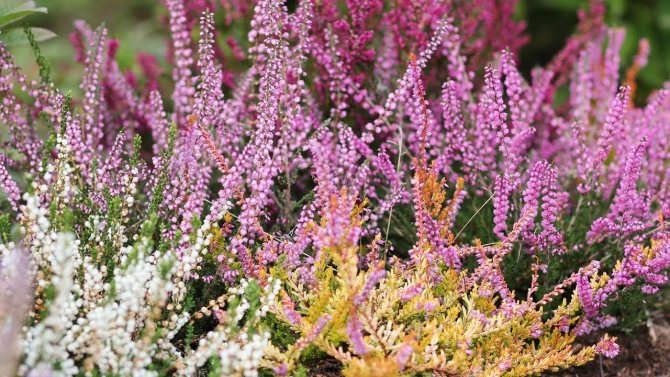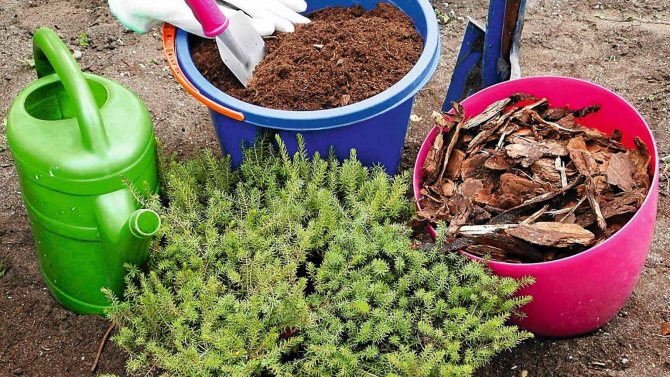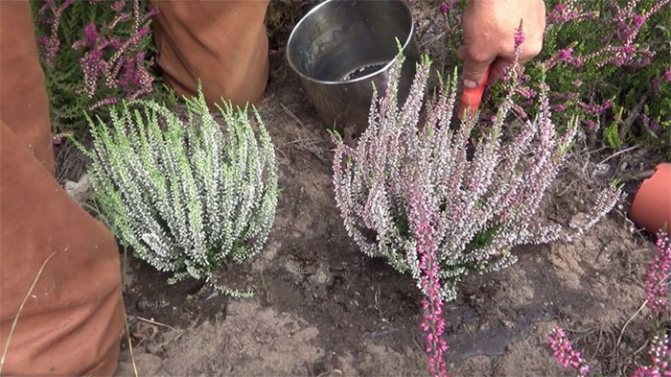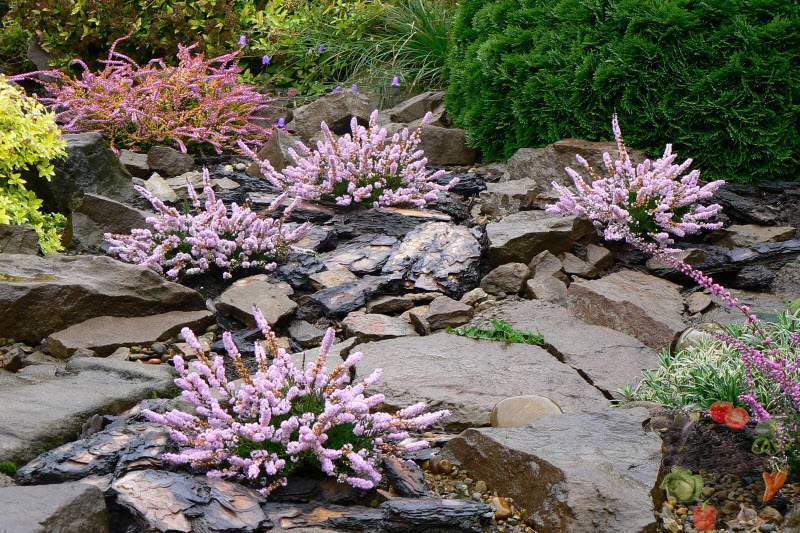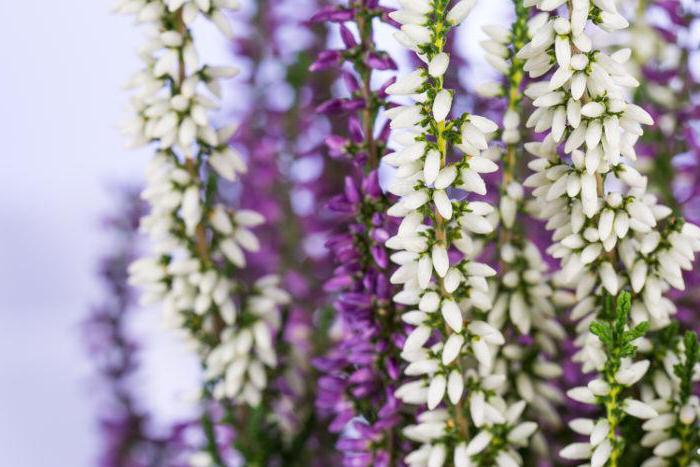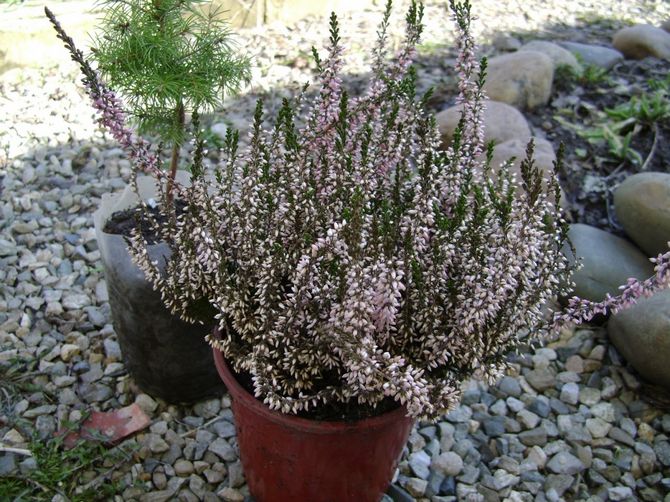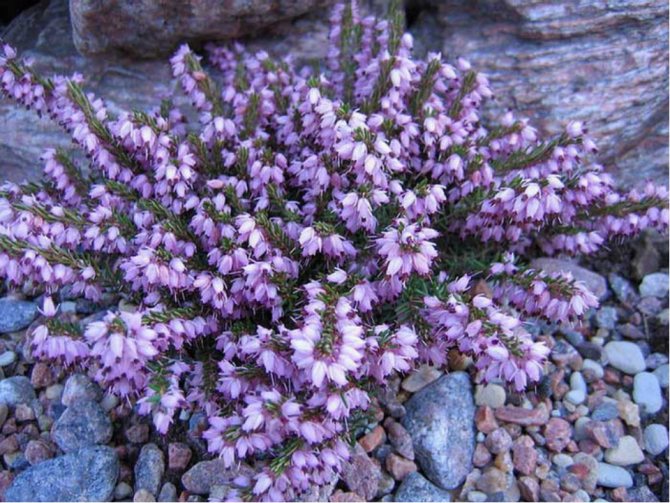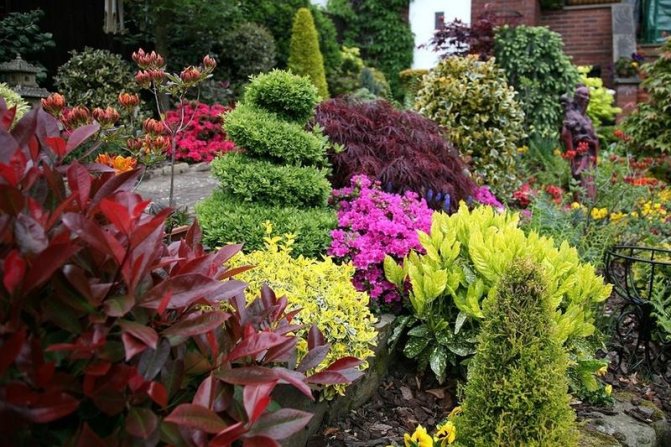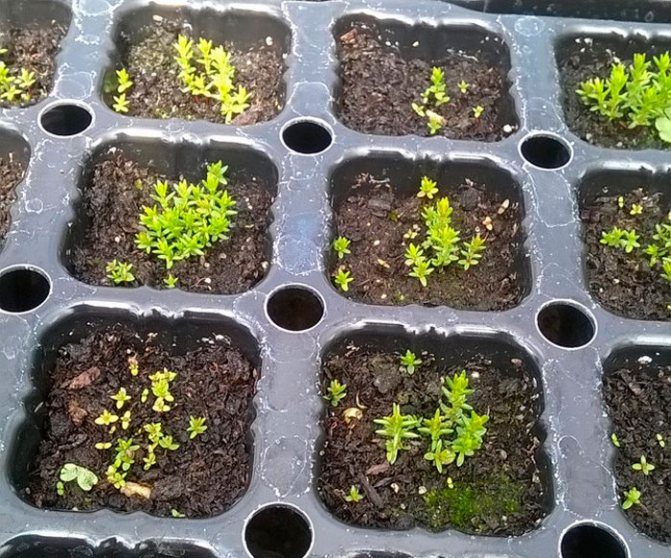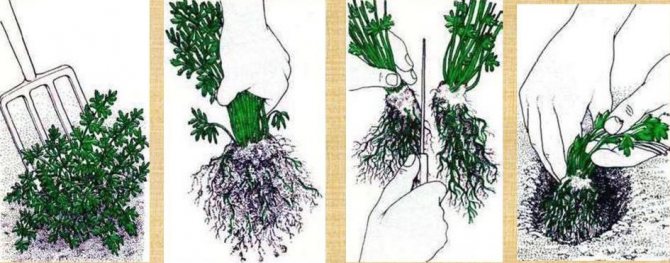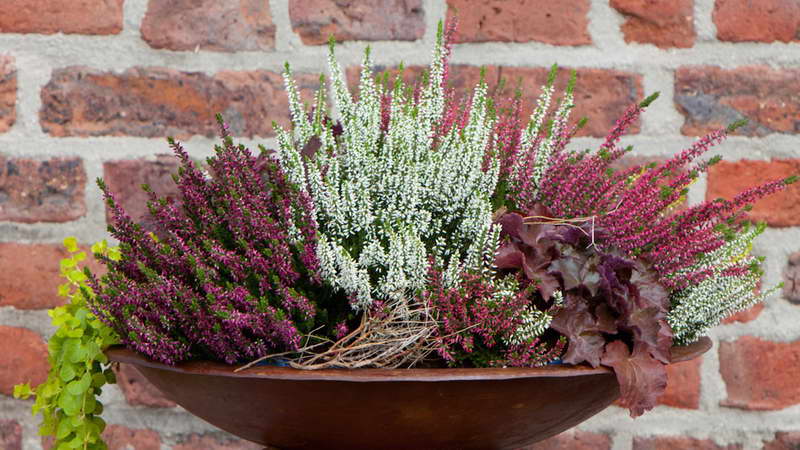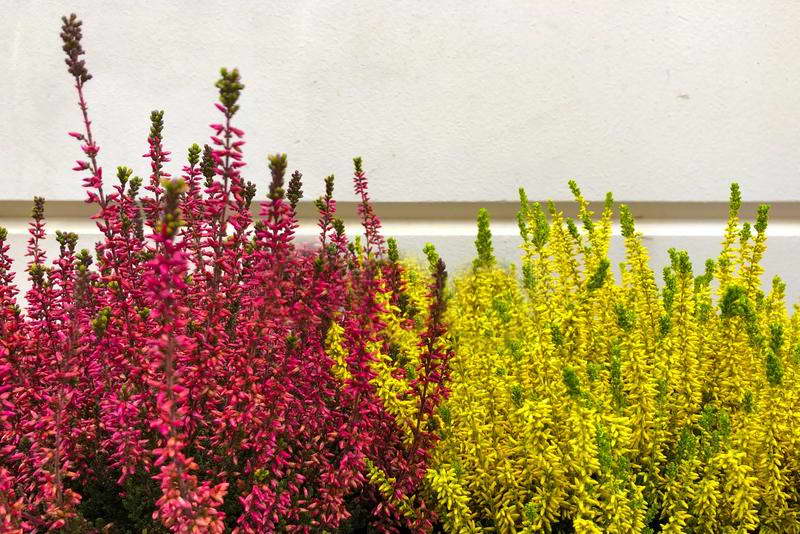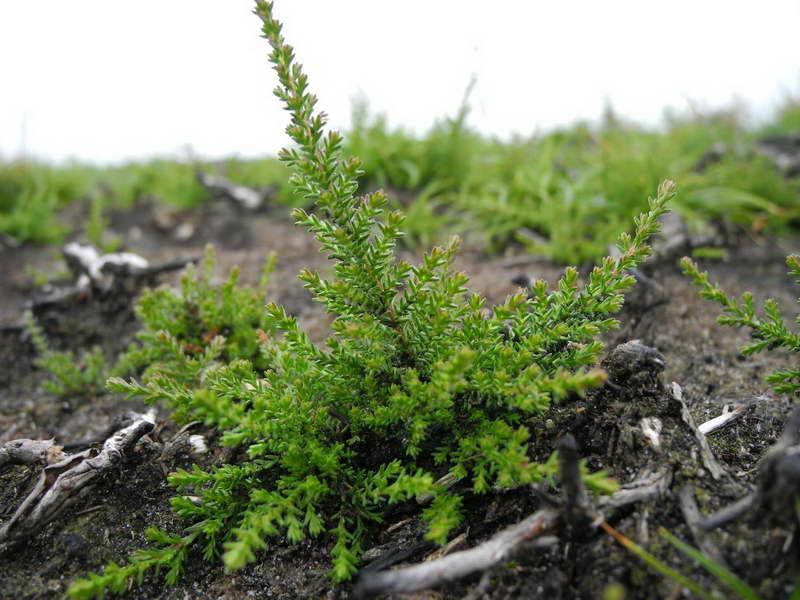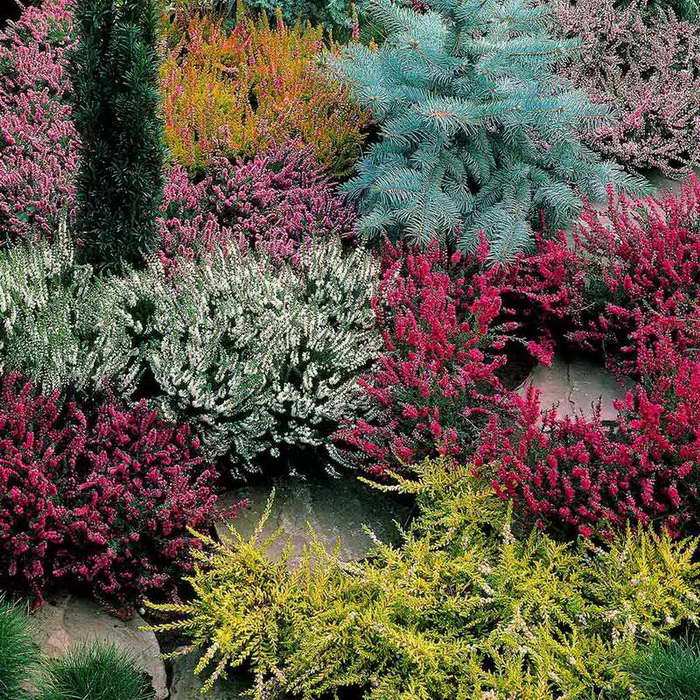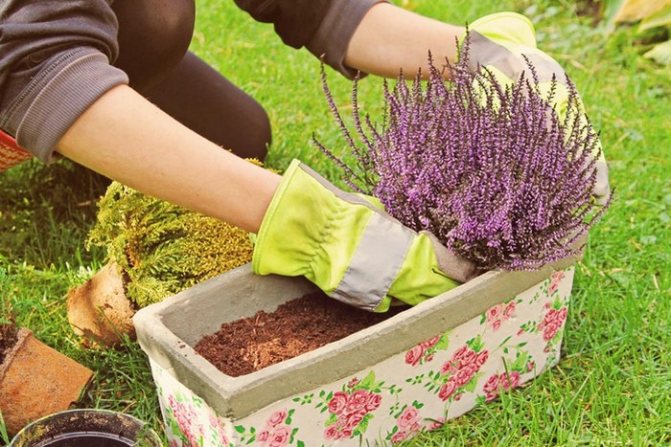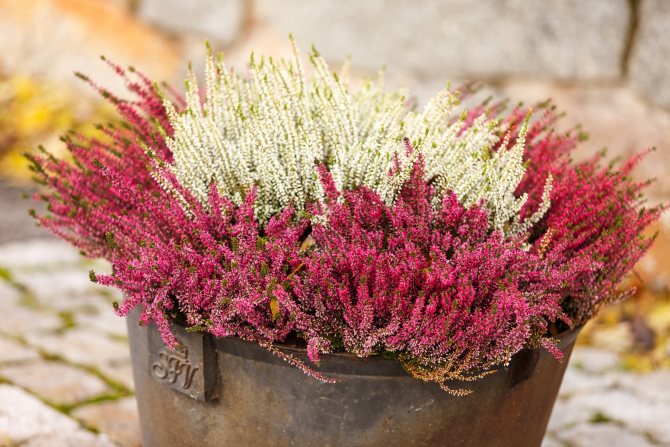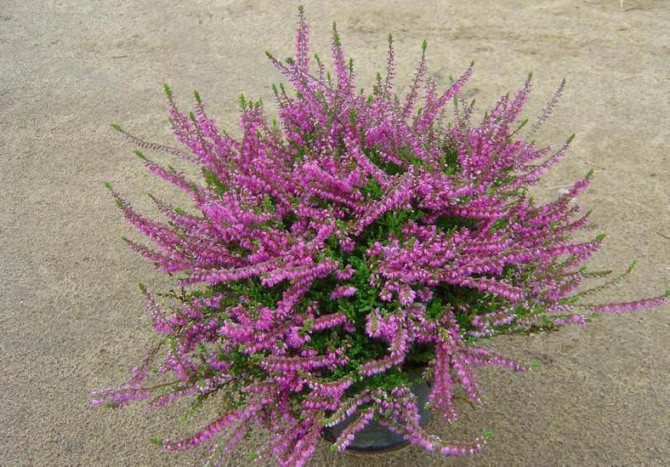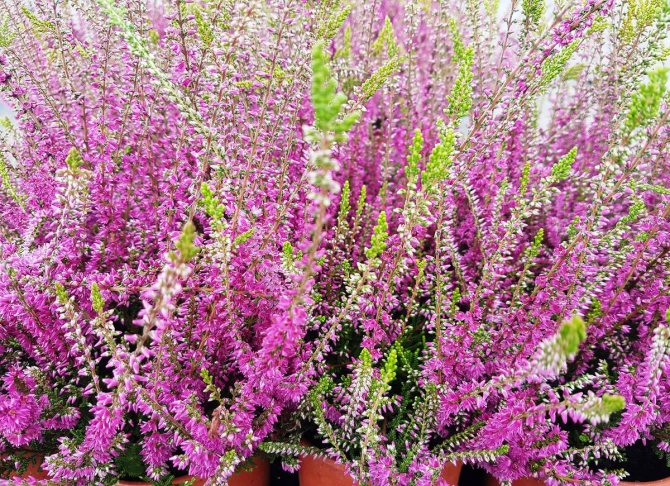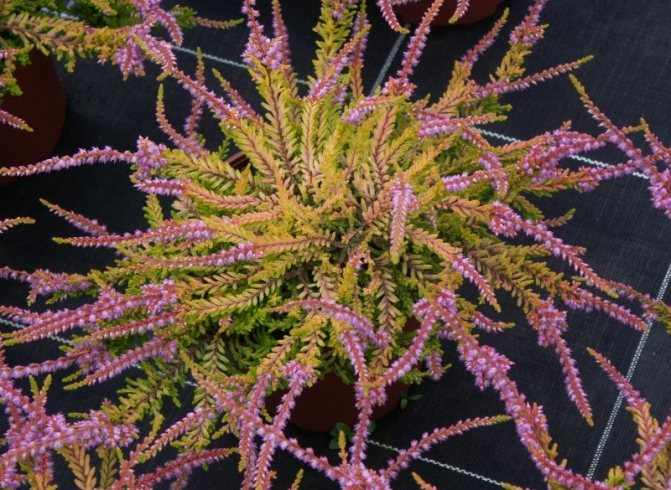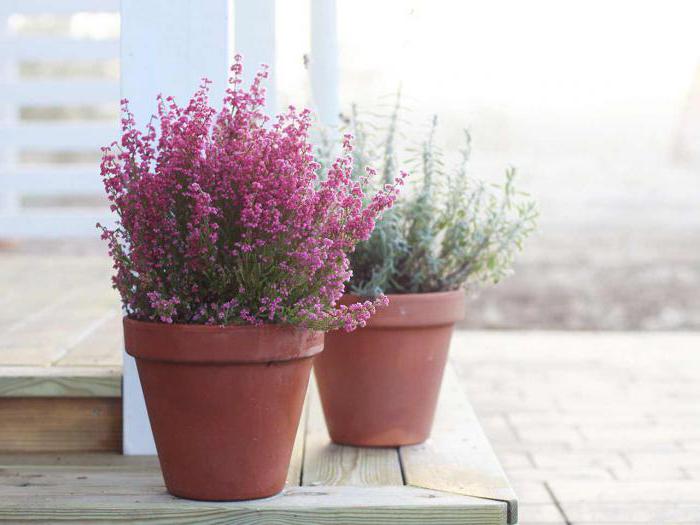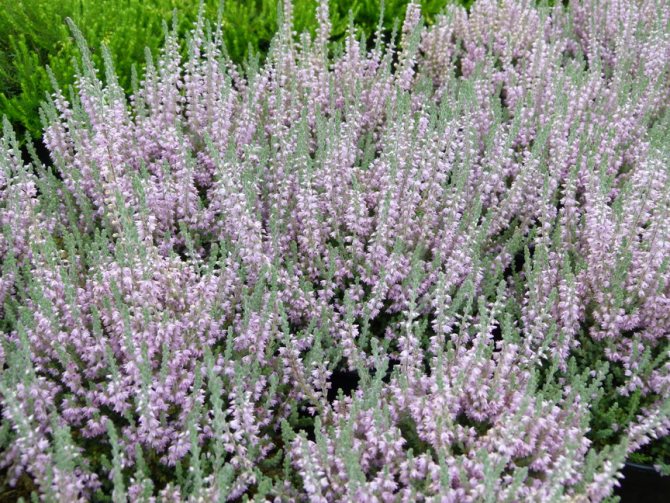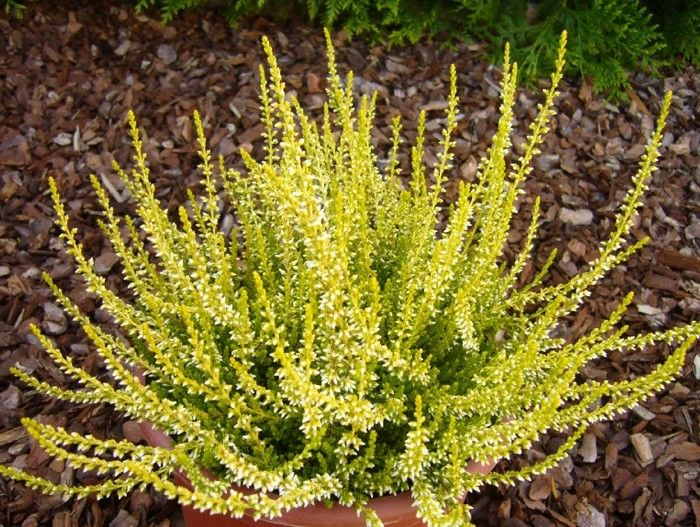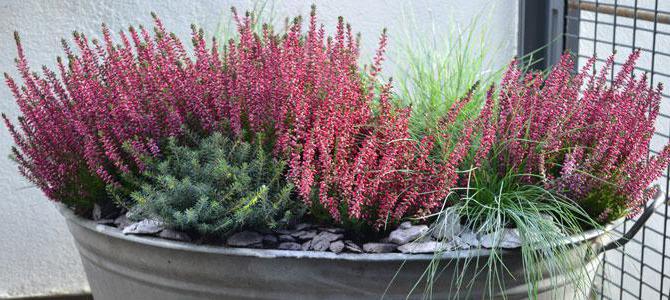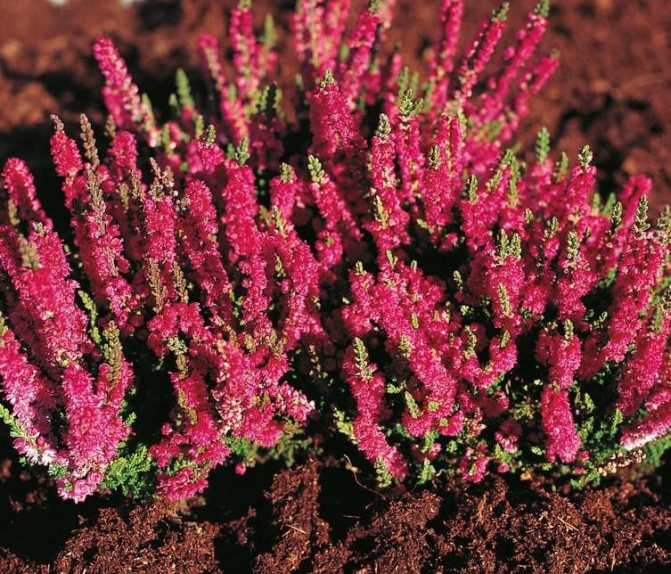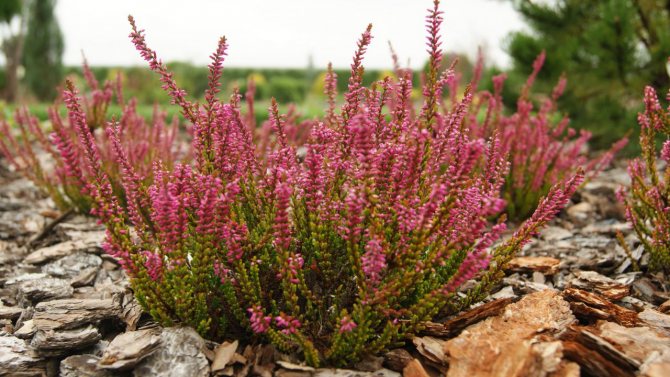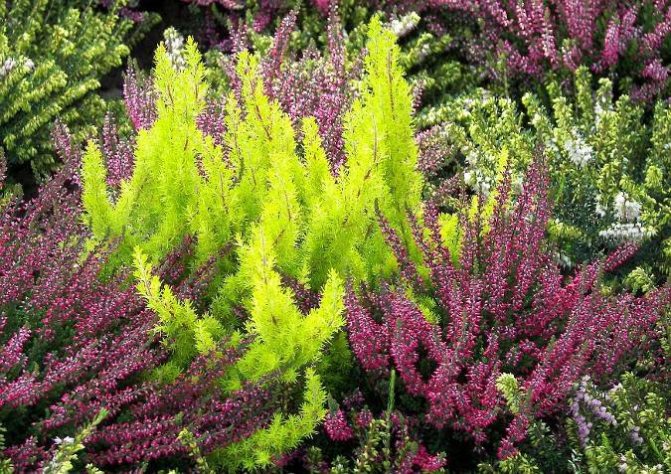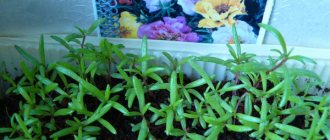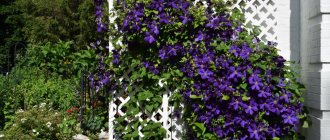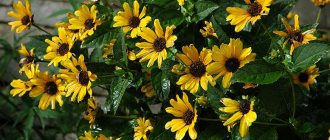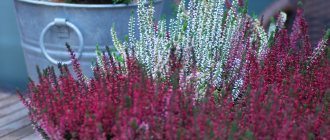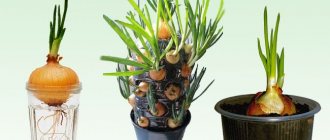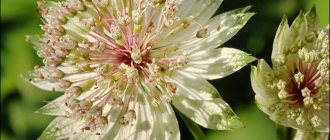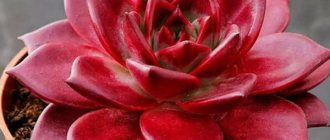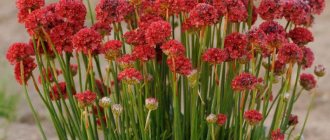Common heather, an evergreen plant, belongs to the Heather family. The botanical term itself means a stunted perennial plant that does not have a main stem. Heather has branching stems; leaves are triangular, small, without petioles. Small flowers, from 5 to 30, are collected in a brush. The flowers are lilac-pink.
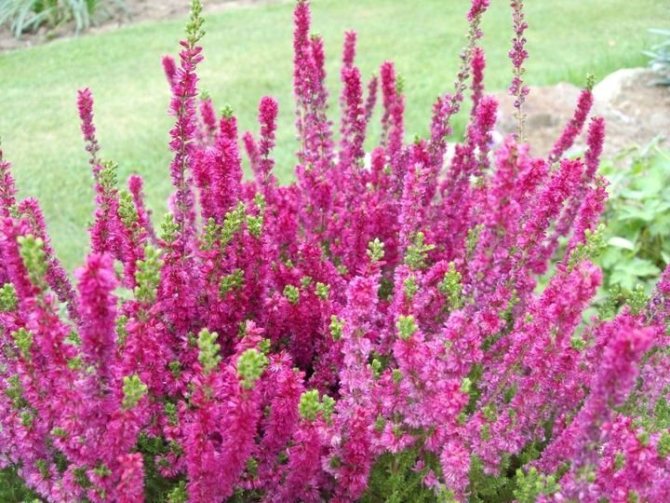
Some sources consider Asia Minor as the "homeland" of heather
Heather ̶ honey plant. In nature, it grows in swampy peatlands, in pine forests. It is believed that the origin of heather comes from Asia, but its modern range is much wider. In our climatic conditions, it can be grown outdoors. Heather will decorate any garden, because this plant is decorative, fragrant, and, moreover, does not require particularly difficult care.
Care features
At home, the principle of caring for any type of decorative heather is approximately the same, although some still require special conditions for themselves.
What should a gardener do and remember? How to care for heather at home?
- First of all, you will need a well-ventilated room, in which the temperature in winter does not exceed + 7-12 ° C (for the life of the plant and its flowering in winter, this condition is mandatory).
- Heather does not tolerate heat very well.
- The plant should have enough light.
- Growing heather at home requires timely watering. The soil should always be moderately moist, and the water can be used for watering and spraying the plant only if it is settled and contains a minimum amount of chlorine. Rain or melt is very suitable. When watering, you need to try not to get on the leaves of the bush, since otherwise it may begin to suffer from a disease such as gray rot.
- As a nutrient medium for growing a plant, it is recommended to take a mixture of marsh and coniferous soil, as well as sand and peat (the ratio of parts is 3: 1: ½: 1).
- Heather, caring for which at home is troublesome, but exciting, is very sensitive to feeding, therefore it should be fertilized very carefully so as not to overdo it. A full range of mineral fertilizers for heather is applied in the spring immediately after pruning. The fertilizer calculation is as follows - from 20 to 30 milligrams per square meter of soil.
- To stimulate growth and shape the bush, it is necessary to cut it off, while avoiding stiff shoots, because it is from them that new branches begin to grow.
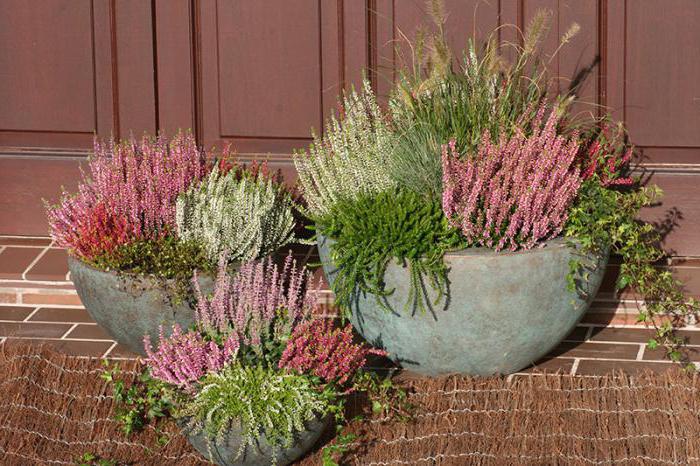

It should be noted that common heather at home behaves unassumingly - it is a completely unpretentious plant in planting and care.
How to plant?
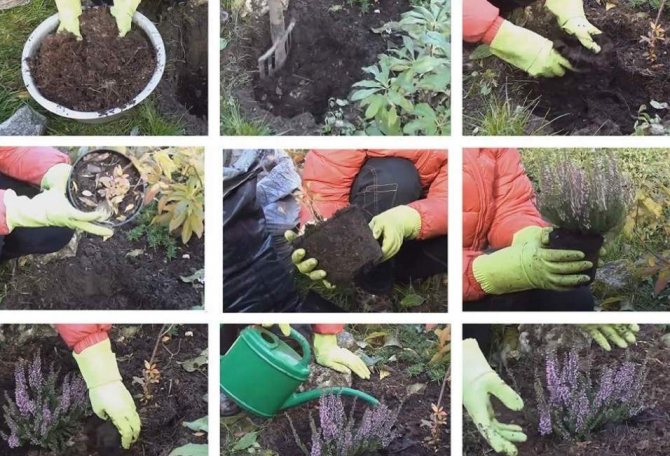

The process of planting heather seedlings
The planting hole should match the size of the earthy clod around the roots. The free space is filled with soil. The root collar is positioned flush with the soil surface. The earth is tamped, mulched with peat and watered. You can immediately fertilize, you can do it after a while.
When planting, plants are placed one in relation to the other no closer than half a meter
Outdoor heather care is not difficult, but it has some peculiarities.
Watering and loosening the soil
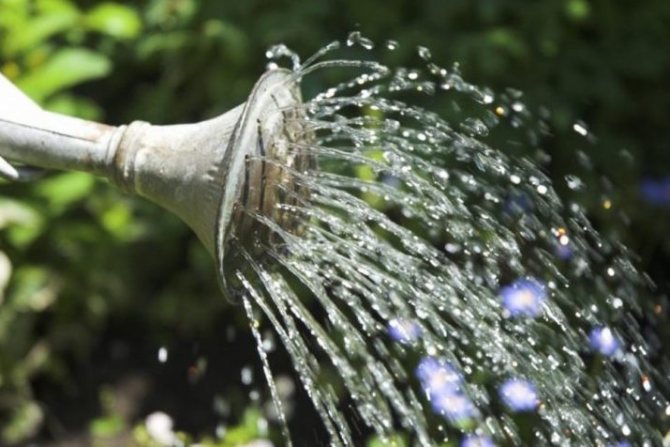

The flower does not require excessive watering
Watering should be regular, but not excessive. In conditions of too dry soil, heather, as an unpretentious plant, will survive, but it will bloom poorly. On hot days, it is advisable to spray the stems and leaves with water.
From September, when many varieties of heather are still in bloom, it is recommended to stop watering.
The soil must be loosened periodically, but carefully so as not to damage the small roots.
Pruning
From the first year after planting, branches should be cut in autumn or spring. In young specimens, the upper branches are shortened, but not more than 5 cm. In plants that have already bloomed, faded inflorescences need to be cut off.
When pruning, make sure not to remove the flower buds, which are located near the edges of the shoots in the heather.
Top dressing
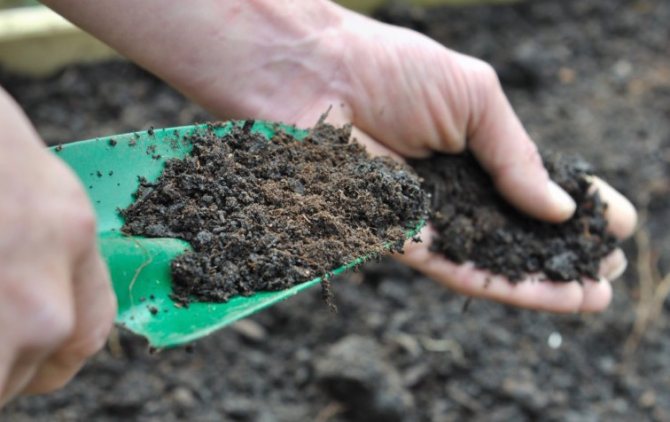

It is enough to feed the heather once a year, usually in the spring, in mid-May. Root feeding is carried out using either liquid or granular fertilizers. Pre-watering is required before any fertilization is applied. It is best to use acidic fertilizers for hydrangeas and rhododendrons. Many people recommend Kemira Kombi and Kemira Lux fertilizers.
Any complex fertilizers are also suitable, which include, in addition to nitrogen, phosphorus and potassium, also microelements. But before their introduction, the land under the plantings is preliminarily acidified with peat.
From organic fertilizers for heather, we use rotted compost. The introduction of fresh organic fertilizers will ruin the planting.
The calculation of the fertilizer dose is carried out according to the instructions attached to the fertilizer. An excess of fertilizer for heather is harmful: the plants become less resistant to diseases.
At the same time, adequate annual feeding stimulates plant growth and promotes more abundant flowering.
Some agronomists recommend another top dressing, in the middle of summer. It is performed if the growth of flowering shoots is slowed down. For this case, any drugs that do not contain nitrogen, for example, potassium phosphate, are suitable.
Reproduction
You can propagate heather:
- seeds (they are very small in a plant);
- cuttings;
- the way of dividing the bush.
Moreover, at home, it is preferable to propagate the plant by seeds, since the planting of this herb can be carried out in almost all seasons. The process of growing in this way is quite long and laborious, but the degree of seed germination is very high - about 90%. The soil should be spilled with a small amount of heated water, then put seeds on it, lightly press down and sprinkle a little with earth. After that, in order to avoid drying out of the soil and seeds, cover the pot with a foil hermetically. In about 30 days after sowing, the seeds will sprout. With the onset of warmth, the seedlings are taken out into the street so that it grows up. They are planted in a permanent place about a year later in 1.5-2.
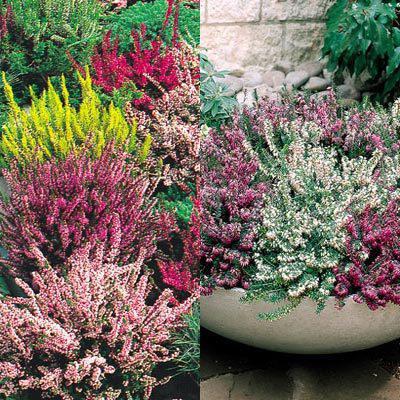

If you do not want to wait so long, propagation can be done by cuttings. For this, shoots should be carefully selected, which should be flexible and have vegetative buds at the ends. It should be remembered that it is the annual seedlings that take root best of all. Planting is recommended to be carried out in special decorative pots with a peat-sand mixture. Cuttings are cut in early autumn, and only from the upper parts of the plant. It is not recommended to cut the branches of flowering bushes for rooting.
When the plant propagates by dividing the bush (after flowering), it is taken out of the pot, then the rhizomes are divided into several parts and then planted in new containers.
As for transplanting plants, it is most favorable to do it in the spring, 1-2 years after the initial planting (but not during the flowering period). Old bushes do not need to be touched.
Practical use
Heather flowers have unique melliferous properties that allow the production of special nectar.Bees flock to it, helping the flower to multiply, while they themselves store up the necessary elements for the winter to maintain life. The honey productivity of this plant reaches 200 kg per hectare. In the famous ballad "Heather Honey" by Robert Louis Stevenson, the main character prefers to die, but not reveal the secret of preparing the elixir of life to the enemy, made from Heather honey. The best alcoholic drinks in Scotland and Norway, ales and spirits, are made from Heather.
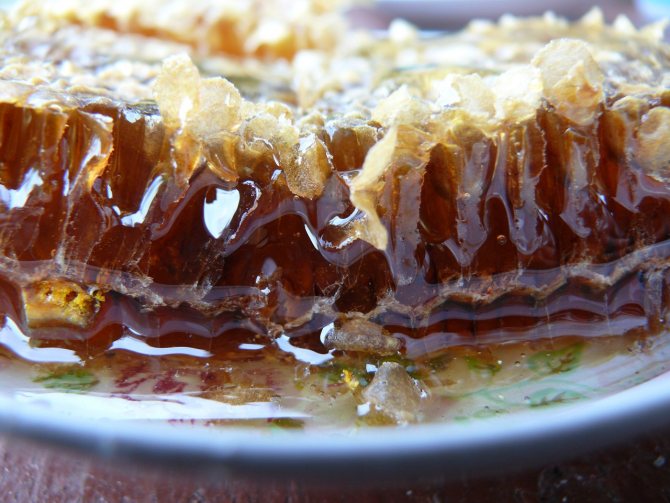

Heather flowers have extraordinary medicinal properties, they are harvested during the flowering period together with the tops of young shoots. The medicinal properties of this flower are recognized by the medicine of many countries, medicines made from this plant have no side effects and are used as sedatives, diuretics, wound healing and anti-inflammatory agents. They are successfully used to treat the gastrointestinal tract, gastritis, cystitis. They have hemostatic properties, prevent the occurrence of malignant tumors. Decoction baths treat gout, arthritis, sciatica and other joint diseases. Along with the above useful properties, they should not be used with low acidity of the stomach, a tendency to constipation or individual intolerance.
Application
Heather at home will be a wonderful decoration for a loggia, attic or terrace. It also looks harmonious in the apartment. Due to the fact that the flowering time lasts almost the entire year, the evergreen plant is a wonderful decoration for almost any interior.
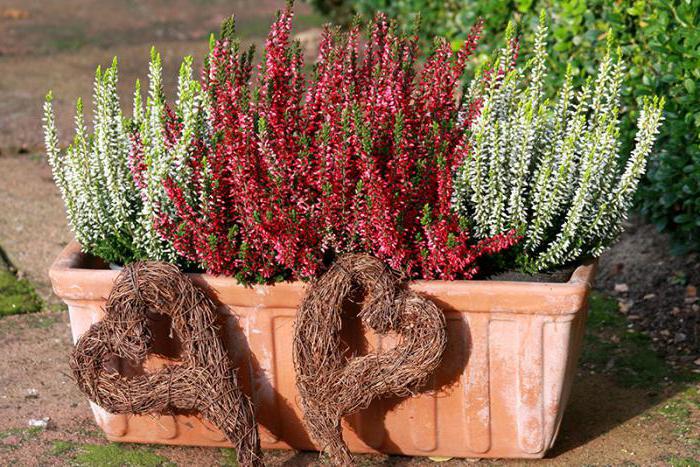

The heather flower, which is quite an entertaining business to care for at home, looks very impressive in an ensemble consisting of several different plants. For example, it especially favorably emphasizes its decorative leafy neighbors. A beautiful combination is obtained when combined with juniper, broom, fern. ...
Heather in landscape design
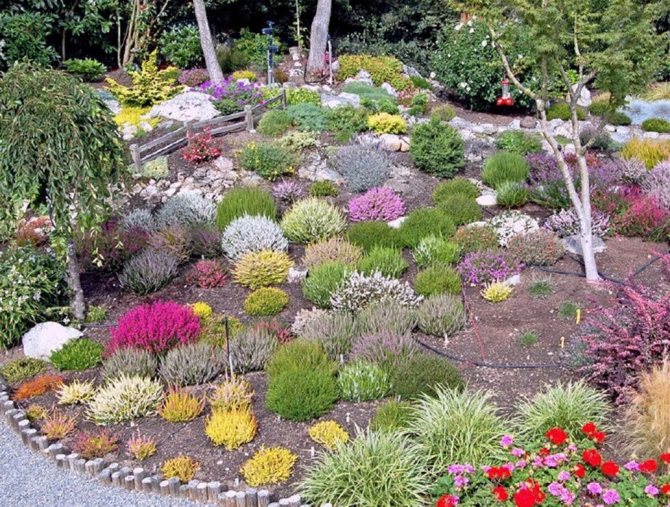

It is known how wonderfully picturesque heather wastelands are vast thickets of heather in association with other plants. Decorative, unique aroma, as well as unpretentiousness of heather make it an excellent material for creating artificial landscape compositions.
Heather is very suitable for decorating uneven surfaces, for example, ledges, hills. The dense plantings surrounding large stones (both on an alpine slide and in rockeries, on a lawn or lawn) look very beautiful.
Plants with which it is customary to plant heather in landscape compositions are ferns, rhododendrons, bushes with bright berries, groups of low deciduous trees, small conifers. Various sizes of compositions are acceptable, from small to gigantic.
The heather multicolored mix is beautiful on its own, even when the color spots are scattered randomly. It is more difficult to create landscape compositions with intricate patterns of heather with inflorescences of various shades. But, with today's abundance of varieties, it is possible.
A decoction made from leaves and flowers
To prepare it, you need to take 100 grams of crushed leaves and flowers of the plant, pour 1 liter of boiling water all together. Next, insist the resulting broth for 15 minutes in a water bath, cool, and then strain. Take 3 times a day, 70 ml before meals.
It is an excellent remedy for dissolving kidney stones, as well as for diseases of the gallbladder and liver.
As you can see, heather, planting and caring for which at home are described above, is not only an amazingly beautiful plant that pleases the heart, but also quite useful. Moreover, the article contains a far from complete list of its qualities.
Heather is an evergreen shrub found throughout the world. In Russia, it is primarily found in Siberia and the European part, where it has chosen pine forests and peat bogs.This plant is very whimsical, it is not easy to care for it in the garden, and even more so at home. But this culture has a lot of fans. It serves not only as an unusual decoration, but also brings many benefits. Growing heather in a pot at home is an interesting activity, the main thing is to take into account the characteristics of the plant.
Varietal variety
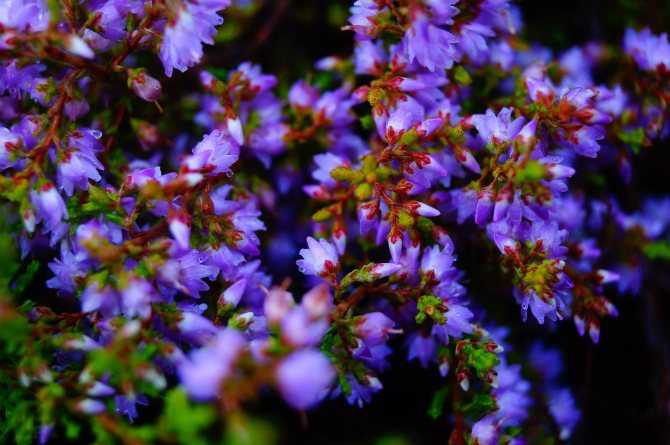

The beginning of flowering heather
Common heather is the only natural species of the Heather family. But in gardens and parks, various varieties of this plant, obtained through selection work, are now growing. Varietal heathers differ from their ancestor in greater decorativeness, a variety of shades of inflorescences and leaves.
Unfortunately, hybrids lose their selectively obtained qualities when propagated naturally (by seeds). Therefore, for new plantings of varietal heather, the material is usually purchased in nurseries.
Heather varieties are classified by plant height into:
- tall (50 - 60 cm high),
- medium-sized (20 - 30 cm high),
- dwarf (creeping, no more than 10 cm in height).
Another classification takes into account the color of leaves and inflorescences:
- with green leaf color (Long White, Darkness, Marleen),
- with a silvery leaf color (Silver Knight, Glendoik Silver, Jan Dekker),
- with golden leaves (Aurea, Orange Queen),
- with double flowers (Beale, Alba Plena),
- with non-opening flowers (Minima, Fritz Kircher, David Eason).
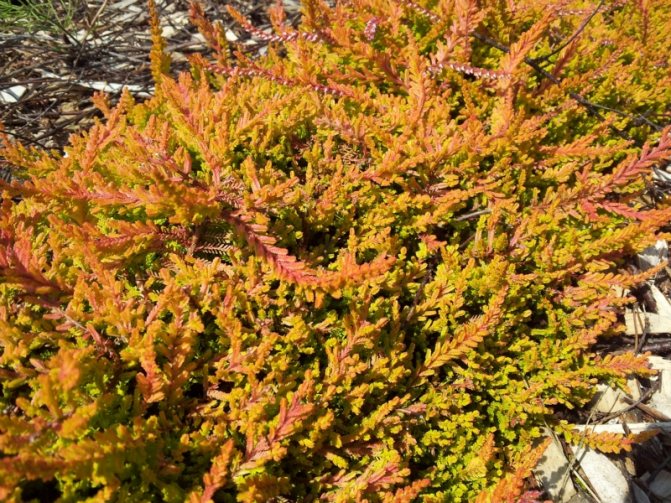

Heather Orange Queen is one of the most common varieties
Orange Queen variety ̶ tall, blooms from August to winter with long inflorescences of white-pink flowers. The leaves are green in summer and turn orange from the end of August. Differs in frost resistance.
Glendoik Silver variety ̶ medium-sized, blooms in September-October with lilac-purple long inflorescences. Branches are deflected with silvery leaves.
Minima variety ̶ dwarf, blooms in late summer with short clusters of non-opening bright pink flowers. The leaves are green in summer and brown in winter.
The best varieties for growing at home
Not many varieties of heather are used for growing at home.
Slim
One of the most beautiful indoor varieties. Neat bushes, up to 40 centimeters high, with light green leaves, are densely hung with inflorescences during the flowering period. The color of the flowers is pink, red, purple, which makes them look like bunches of pomegranates.
Wintering
This variety grows up to half a meter, the flowers are also larger than those of slender heather. The flowers are white, the size is up to 2 centimeters.
Heather mix fell in love with many gardeners due to the fact that its flowers are painted in the most different and vibrant shades. It can be pink, purple, white. This variety reaches a height of half a meter and grows very luxuriantly. Blooms in July.
Ordinary
The height of the common heather is more than half a meter, it also branches strongly, the color of the stems is reddish. Flowers of lilac and pink shades, do not fall off for a long time even after the end of the flowering period.
Varieties
Despite the fact that there is only one species in the Heather genus - Common Heather (Calluna vulgaris), it has about 500 varieties that differ in shape, color of leaves and flowers, as well as size. So, for example, the Heather or Arboreal tree (Erica arborea) is a plant up to 7 meters high. Small gray leaves, needle-shaped, up to 1 cm long, cover elastic, numerous branches. A complex inflorescence, reminiscent of a pyramid, up to 40 cm long, composed of small, white, bell-shaped flowers with a very pleasant smell. Cultivated since 1658 goals.
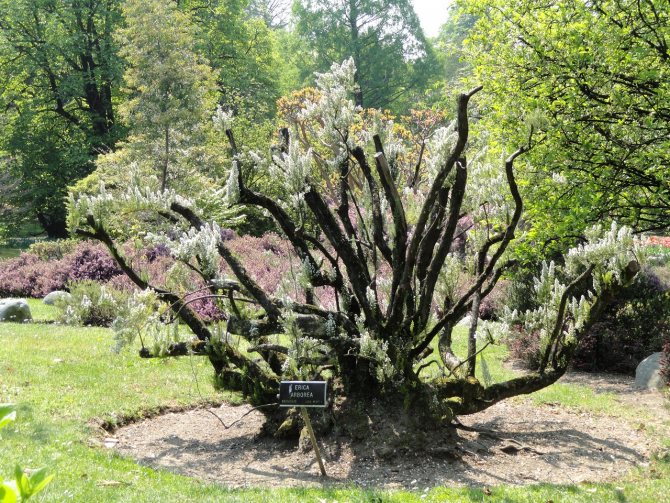

The houseplant Heather Slender (Erica Gracilis) is one of the many varieties most suitable for growing at home. It is a small shrub 30 cm high, has a large number of lateral branches on which small needle-like leaves are located, covering all the stems of the plant. Flowers of red or bright pink color, collected in racemose inflorescences, have the shape of a bell, ranging in size from 5 to 10 mm.
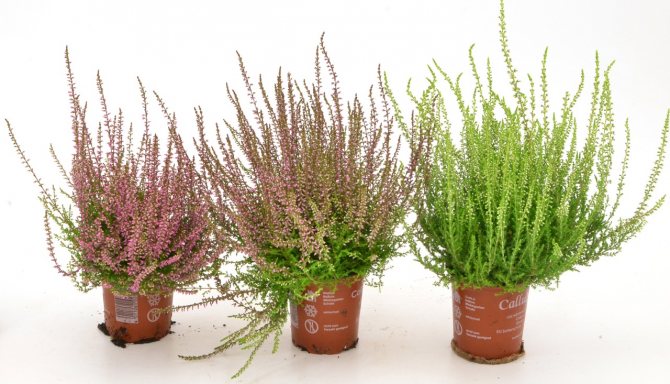

Prerequisites for a flower
In an apartment, heather lives less than in the wild or in a garden - up to two years. In order for the plant to delight with flowers all this time, it is necessary to grow it correctly and then take care of it.
Location and illumination
When choosing a room in which you plan to grow heather, you need to consider the following:
- it must be well ventilated;
- the plant is harmed by heat, so you need to prevent overheating (do not place next to heaters and batteries);
- a lot of diffused sunlight.
The ideal option is an insulated loggia, where the desired temperature will be kept in winter. But avoid the south side and direct sunlight.
Temperature regime
High temperatures are fatal for heather. Therefore, in winter, + 12-15 degrees is enough for him, in summer - up to +25. When growing seedlings, try to keep the temperature around + 18-20. Contraindicated to the plant and stuffiness. On the other hand, temporary taking out to the street in spring and autumn on warm (but not hot!) Days will have a good effect.
Indoor humidity
An abundance of moisture is important for heather; in rooms with dry air, it will grow poorly. To avoid this, gardeners are advised to spray the bushes.
Optimal soil composition and pot volume
A shallow and wide pot is best for heather, but when planting the plant, you need to focus on the roots. The depth of the container should be greater than their length, and as the heather grows, it should be transplanted into a larger pot. Often heather is planted in long boxes, then you can assemble a composition of several varieties.
As for the land, the best option is an acidic soil with a base of peat and humus, in which there will be a sufficient amount of organic matter. Good drainage is also important.
Landing conditions and procedure
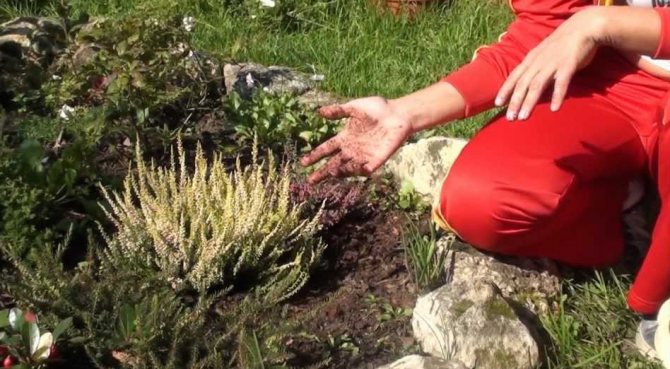

For heather, choose the most spacious and well-lit places.
For better survival, it is recommended to plant heather in open ground in the second half of spring, from about the end or mid-April. Over the summer, the plant will get stronger, and it will be easier for it to survive the winter cold. But if necessary, planting can be carried out in October.
Seat selection
For planting, choose a place well-lit by the sun. There should be no tall, spreading trees or other objects casting a dense shadow nearby. Slight shading during daylight hours is allowed.
The soil
Heather loves acidic soils - with a pH ranging from 3.5 to 5.5. Therefore, if the soil on the site is alkaline or even neutral, it must be acidified, and the first time to do this before planting heather.
You can acidify the soil:
- sour, so-called high-moor peat (it has a brown color),
- rotted sheet compost,
- rotted coniferous litter,
- colloidal sulfur,
- ferrous sulfate.
There are no other requirements for the nature of the soil. Even sandy, very poor soils are suitable for heather. Clay soils are also suitable, provided that when planting, drainage from a layer of pebbles or rubble will be arranged under each plant.
Requirements for seedlings
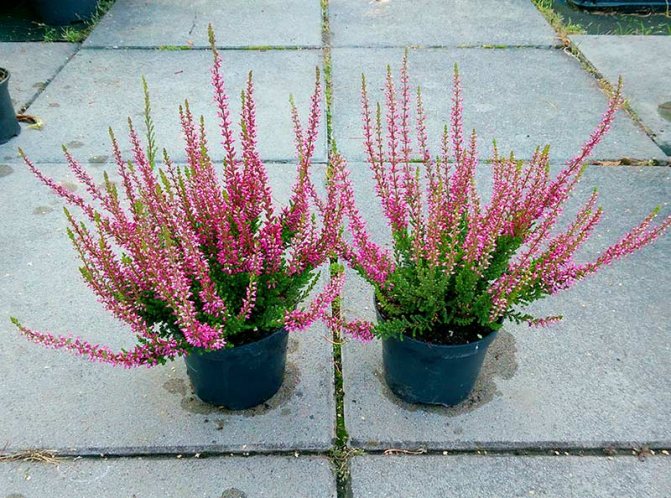

Heather seedlings ready to transplant
You need to purchase heather for planting in containers so that the root system is located in an earthen coma. The roots of even very young plants have already formed a symbiosis with mycelium - mycorrhiza... If it is not transplanted with the plant, it will most likely not take root in its new location.
The soil in the container should be slightly damp, and the heather itself should have both old branches and young, fresh ones.
Rules for planting a heather flower at home
You can plant heather with seeds or seedlings. When buying seedlings, you must carefully consider each one, since even dead bushes do not lose their leaves and seem alive.
Terms and technology of planting works
Seed planting is carried out in any season as follows:
- Bury the seeds shallowly in a mixture of peat, softwood, and sand.
- Cover the pots tightly with plastic or glass to create a greenhouse effect.
- Ventilate periodically, water the ground when it dries.
- 8-10 months after the seeds have sprouted, the plants can be transplanted into separate pots.
Preparing for winter


Shelter of a plant for the winter with spruce branches
In order for heather to survive even a fierce winter, it should be prepared for the onset of frost. Pre-winter care consists of the construction of a double shelter. Usually, heather warming is carried out in late October or early November, while the soil is still not frozen.
First, the soil under each plant is well sprinkled with a layer of peat or some kind of non-woven material to cover the plants (in extreme cases, you can use dry leaves). It is recommended to make a layer no less than 10 cm and rather dense. Then the bushes are covered with spruce branches. Around the middle of April, the spruce branches are removed, and the root collars of each specimen are freed from the peat.
Crop care rules
Heather is a whimsical plant, and if you decide to grow it at home, then you will need time and patience. Fortunately, you need to care for different varieties in the same way. Mulching has a good effect on heather, but be sure to remove dry leaves and branches.
Watering and irrigating the bush
It is important that the soil for the heather is always moist. It is also sensitive to water. It is necessary to water only with settled water, practically without chlorine. If the water in your area is highly chlorinated, then stand it for 2 weeks, or even better, use melt or rain water. Pour carefully, right at the root, so that water does not get on the leaves, otherwise gray rot may appear. But for better hydration, the plant can be lightly sprayed.
What and when to feed
Top dressing is very important for heather, but you shouldn't add too much. During the period of active growth, fertilize with complex mineral fertilizers. The first time is in the spring, after pruning. One square meter requires 20-30 milligrams. Organic is also good, and use spruce bark or sulfur to oxidize the earth.
Shaping and pruning
Pruning is another activity required for a plant. It is carried out after flowering. Fresh stems are removed to form a shrub. At the same time, those who have become stiff must be left - they will then give new shoots. Some gardeners prefer not to prune the heather in order to keep the flowers longer, but nevertheless, thanks to pruning, the shrub grows more luxuriantly and forms flowers better.
Transfer
Heather needs to be transplanted into a new container every year, as it grows rapidly. You need to transplant carefully - the plant is sick for a long time. The root system is especially affected, since it is shallow and has many small roots. Therefore, try not to damage the earthen ball. The pot should be selected with large drainage holes and larger than the previous one, but for the bush it should remain a little cramped.
Exposure to disease and parasites: prevention and treatment
At home, heather rarely gets sick, but there are still several diseases and parasites that a gardener may encounter. First of all, it is gray rot. It occurs due to excess moisture and stagnant water at the roots. White growths and spots on the plant, withered leaves testify to gray rot. You can fight it with the drugs Fundazol and Topaz. As a preventive measure, spray the leaves with a weak solution of copper sulfate.
Most diseases and parasites are also easy to deal with:
- Against powdery mildew, due to which white and brown spots appear, Fundazol will help.
- Rust - Topaz preparation. It can be recognized by the red spots on the foliage.
- Aphids - Inta-Vira and Decis preparations.
- Spider mite - Aktellik, Aktar.
But if the growth of a shrub has slowed down, its branches become crooked, and the color of leaves and flowers has changed, then the plant is infected with viruses. In this case, only the destruction of the diseased heather helps so that the disease does not spread to other bushes. It is best to burn them.
How to store heather in winter
In order for heather to survive the winter safely, it must be kept cool (up to +8 degrees) and the soil must not dry out. But at the same time, watering is slightly reduced.
Diseases and pests
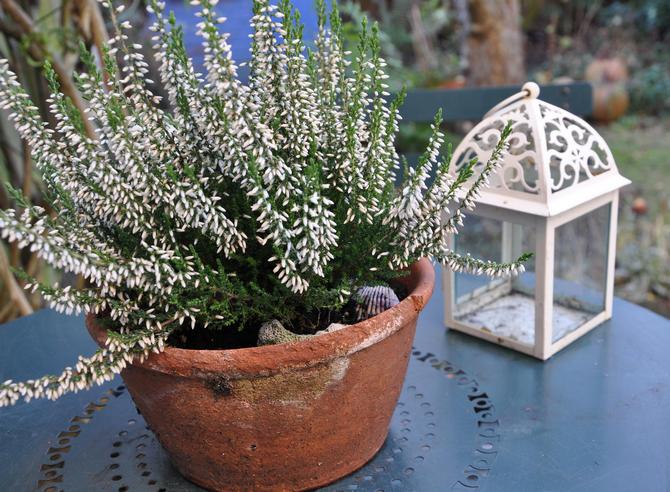

The increased humidity of the soil and air contributes to the defeat of heather bushes by late blight, which is a fungal disease. The disease is manifested by the fact that the leaves of the plant fall off, a gray bloom appears on the trunks and shoots. Shoots, mostly young, bent downwards and die off. To cure the plant completely, all branches affected by late blight are cut off, and the bush is necessarily sprayed with a 1% solution of copper sulfate. Three treatments should be done with an interval of 10 days. For the purpose of prevention, it is advisable to do the treatment even in late autumn and early spring.
When heather is ill with powdery mildew, the leaves and shoots of the plant become covered with spots and light gray bloom, causing them to dry out. Against powdery mildew, it is recommended to apply spraying with preparations that contain sulfur or copper. For example, Topaz, Fundazol, Bayleton, Topsin, and others.
Heather bushes are rarely affected by viruses. But if this still happens, then there is a deformation and a change in the color of flowers and shoots. To prevent the spread of a viral infection, such bushes must be dug up and burned.
It should be noted that the presence of stagnant water in the soil, an excess of organic matter and mineral fertilizers can also lead to plant disease and cause withering of young shoots and a change in leaf color. For this reason, it is best to find a more suitable site for planting heather elsewhere.
The scale insect, which sucks the juice from the leaves of the plant, is the main pest of heather shrubs. To get rid of the pest, a soap solution is used with the addition of insecticides to it, with a wide spectrum of action.
Reproduction methods
Heather can be propagated by seedlings and seeds, and both methods give good results. If you keep the temperature at home, you can breed heather at any time of the year.
Saplings
Propagation with seedlings is a fairly quick and easy way. Cuttings for this purpose should be:
- flexible;
- with vegetative buds at the ends;
- annuals;
- without flowers;
- from the tops of the bushes.
It is recommended to plant them in special pots, in a peat-sand mixture. Choose autumn for breeding.
Seeds
Seeds are the safest way to breed heather. Germination rate is 90%, moreover, the time of year affects less planting of seeds. However, seeds require more time and labor than seedlings. Sowing takes place as follows:
- Pour the prepared soil with warm water.
- Spread the seeds on the ground, lightly press them down and sprinkle with soil on top.
- To prevent the earth from drying out, cover the pot with plastic wrap.
Seeds sprout in about a month. You can also stand the seeds off the ground, in cups or saucers. To do this, they are laid out in a dish in a thin layer, poured over with water and also hermetically closed. After the first shoots appear, they are planted in pots.
Description
Heather is an evergreen fast-growing shrub up to sixty centimeters high. It can be both branching and creeping. The plant has decorative needle-shaped leaves of various colors, ranging from light green to silvery gray. There are varieties with multi-colored leaves: red, orange or gold. It is they who give the heather a special charm.
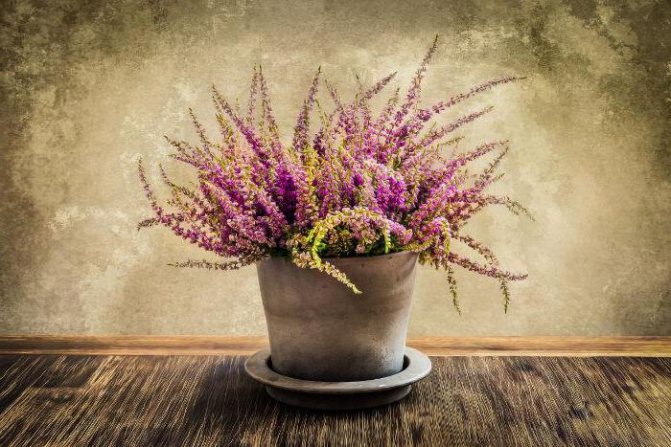

The plant has a different time and flowering time, depending on the selected species. When this period comes, the bush becomes a bright decoration of any room for a long time. For example, slender heather pleases in autumn and winter. Small flowers are similar in shape to barrel-shaped bells, formed by not fully accreted ordinary or double petals. They are found in white, purple, lilac-pink or other colors and cover the entire plant.Inflorescences are round or pyramidal in shape. This is a magnificent honey plant with the most delicate aroma. From the side, the shrub looks like a dazzling flash.
Frequently asked questions and answers to them
Gardeners who are just starting to grow heather have a tough time dealing with it. It is necessary to know how and what to do at each stage of its growth, as well as other features of the culture.
When does the plant bloom?
The flowering time of heather is the end of August. Its great advantage is that even after the flowering period, the inflorescences do not fall off, but remain on the bush, so that the latter does not lose its decorative qualities for a very long time.
What to do after flowering?
At home, heather is often grown as an annual plant. In order for the bush to survive the winter safely, and the next year to please you with flowering again, appropriate feeding after flowering, as well as cutting, is necessary. It is also important to keep temperatures low during the winter months.
What is the lifespan of a plant?
In the garden, heather can bloom for a long time - up to 5 years, while in nature its life is sometimes counted for decades. But at home, this period is much shorter - 1 or even 2 years, if all the necessary conditions are created.
Why does heather dry?
Heather dries up from lack of moisture. In dry seasons, you need to provide abundant watering, do not forget to spray the plant, humidify the air, if possible. Also, the reason may lie in the soil, which has become slightly acidic. This requires appropriate feeding, for example, you can add acid with water twice a year.
Despite the difficulties in planting and growing, heather remains one of the most interesting and useful plants. In addition to beautiful flowers that can be admired for a very long time, it is also used in medicine, cosmetology, therefore it is highly valued by gardeners.
Most home plant lovers prefer to grow those that remain elegant and colorful all year round. Such is the heather - a low and beautiful evergreen shrub growing on peat soils of wooded and forest-steppe regions. This hardy and drought tolerant plant grows well in the hills. Florists often plant graceful and unpretentious heather bushes at home.
Symbolism
Many legends are associated with it, it is not for nothing that the national plant of Norway is Heather (Rosslyng), and the meaning of the flower includes an unbending spirit, courage, loyalty and bewitching beauty. According to Scottish legend, the bush received these gifts from the Lord, because he agreed to live in the wastelands and swamps, in forests and rocky slopes. This flower is endowed with divine power capable of healing wounds, human ailments, the healing properties of this relic have been known for many generations.
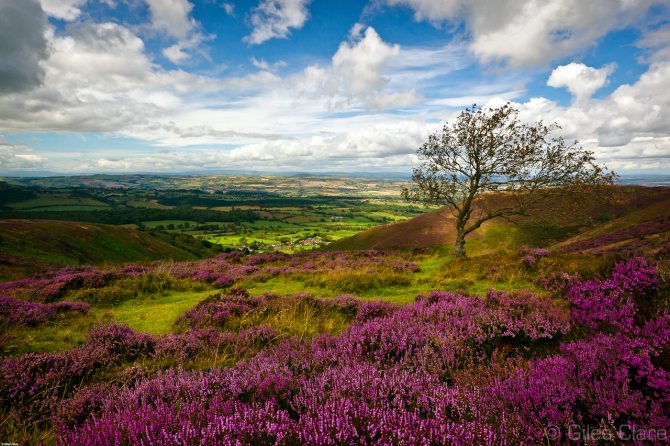

Landing
Blooming heathers appear in garden shops in late summer. During this period, they are usually bought and planted.
Requirements for soil, planting site
Heathers look great next to each other, prefer sunny places and acidic, well-drained soil - for example, as in their natural environment - in the forest, foothills. They do not like strong winds, so it is good to plant them in the company of taller conifers and rhododendron shrubs - also due to similar soil requirements. To enjoy the flowering of shrubs, it is worth choosing a place where the sun shines for at least 6 hours a day.
There are many different varieties that will grow well in partial shade. The exception is golden-orange varieties: they need the sun, if planted in the shade, instead of golden, they will become aquamarine.
Heathers are acidophilic plants and require acidic soil.
The ideal soil pH should be 4.5-5.5; at higher values, a little sour peat should be mixed with the soil. You can also buy soil for rhododendrons and other acidophilic plants. These mixtures are available in almost every garden store.It happens that a novice amateur plants heather in a different soil, unfortunately, the plant often dies.
Peat is very permeable and dries quickly. Therefore, it is advised to mix peat with garden soil. Usually a mixture is suitable: 3 parts peat for 1 part land (with the exception of highly alkaline loamy soils - then you can take 4 parts peat and 1 part garden soil).
If the soil in your garden is heavy, loamy, you should consider a taller flower bed surrounded by a layer of natural drainage in the form of gravel or pebbles. Heather will not be damaged by adding compost to the soil when planting, although these plants usually do well even with poor soil.
Is forest soil suitable for growing heather? A very common question. In theory, soil from a forest may be suitable (wild heathers grow in forests), but there is no guarantee that soil from a nearby forest is 100% acidic. It is better to do a soil analysis or purchase a pH meter - a device that shows the pH level of the soil. If there is at least 4.5 - you can plant!
Planting work
Heather does not tolerate transplanting well, so you should carefully consider the landing site in advance. General guidelines recommend planting shrubs in the spring and fall, but today's supply of well-rooted potted plants allows heather to be planted almost all year long until the soil is frozen.
The planting hole is dug 2 times wider and deeper than the root ball, individual bushes should be planted at a distance of 25-50 cm from each other.
Depending on the strength and growth rate of the selected variety, plants are usually planted at intervals of 20-30 cm or 10-15 plants per square meter. For large varieties, the planting rate is 8 pieces per square meter, which will give a planting pattern - every 30 centimeters. After all, the plants will grow - in a year or two they will need a place.


What is the planting depth? Heather has a shallow root system (about 15 cm), so it is better to dig a small hole, add peat, mix it with garden soil and plant a plant. With a large number of seedlings, you can simply mix the peat with soil and create a layer of 20 centimeters in size.
After placing the plant in the prepared soil, you need to make sure that the top of the roots is flush with the ground. After planting, the soil around the seedlings is watered abundantly and mulched with acidic pine bark - this will prevent soil drying, weed growth, help maintain a low pH and provide a decorative effect.
Attention! The heather should not be planted too deeply or covered with too much soil or mulch.
There are no contraindications for planting different varieties next to each other. The ideal heather shrub in the garden is irregular in shape and occupies a slightly raised flower bed, and the different shades of flowers intertwine like waves.
Heather can also be successfully planted in a box, in soil obtained by mixing garden soil or substrate with peat in a 2: 1 ratio.


If you purchased seedlings
It is preferable to plant rooted heather plants in the garden in the designated place for them around May. If it is decided to plant in the fall, then it is carried out no later than September, so that the seedlings can get stronger and take root before the onset of cold weather.
It is recommended to purchase heather in garden centers or specialized nurseries. The bushes are sold in plastic pots.
How to grow heather in your garden? Before planting, purchased seedlings must be well watered. Gently removing the heather from the container, gently straighten the roots, which are usually collected in a lump. A bush with tangled roots will not be able to actively take root for a long time and will die.
A wide hole is prepared under the heather. They never dig it deeply, since the roots of the bush are located close to the surface. If in the selected area the soil is clayey, poorly conducting water, drainage is arranged. Excessive moisture only harms heather.To do this, before planting the plant, pebbles or crushed stone of the middle fraction are poured into the planting hole for a couple of centimeters. Then water is poured into it, a seedling is placed, covering it with earth no higher than the root collar.
After planting a plant, the soil must be compacted with your hands and watered again. Then the garden bed around the seedling is mulched with fallen needles or peat. Even the bark of coniferous trees is suitable for use.
Heather varieties
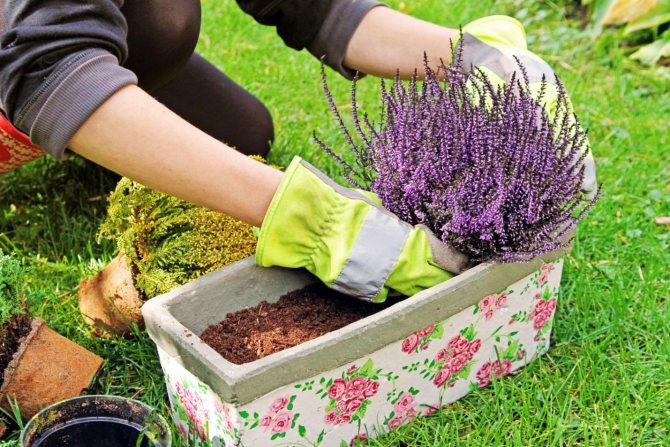

Before planting common heather in the open field, learning how to care for it, we suggest that you familiarize yourself with the varieties, among which you can choose a suitable plant.
- Heather Allegretto - the maximum plant height can be no more than 40 centimeters. It blooms for 2 months, from August to September. The flowers are purple-red. Well suited for growing in areas with cold climates and can tolerate frost.
- The maximum height of the Dark Star is 20 centimeters. It grows rather slowly, blooms with ruby red flowers.
- If you want a plant with purple flowers to grow in your garden, then it is better to opt for the Silver Knight. The bush blooms from August to October, grows up to 30 centimeters in height. It takes root best in areas with a hot climate, as well as in places with a lot of light.
- Carmen looks very nice. It has beautiful purple-pink flowers. Perfect for places where weather conditions change frequently.
These are just a few varieties that you can familiarize yourself with by looking at the photo.
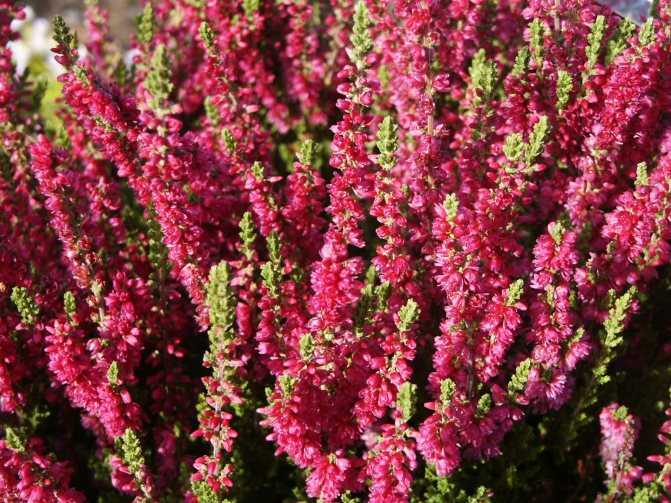

Important!
When choosing a variety, it is better to focus on those that do not fully bud when flowering. If the air temperature drops, then the kidney that has not opened will delight with its color for a long time.
The nuances of preparing a plant for winter, depending on the regions
In order for the plant to endure the winter normally, it is necessary to prepare it for wintering in advance.
In the Urals and Siberia
People who grow heather in Siberia and the Urals must make sure to prepare it for the winter frosts. Preparation begins in early autumn, before severe cold weather begins.
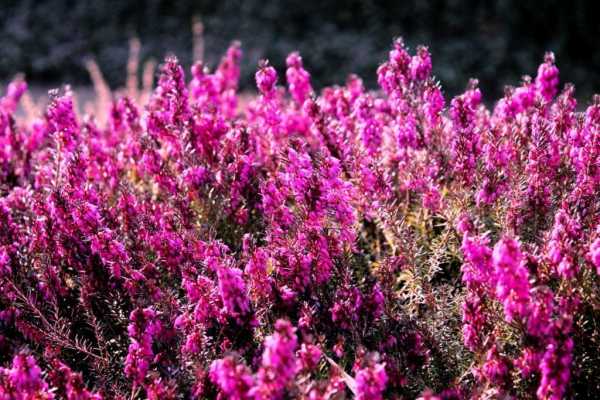

If it's too late to prepare, the plant won't survive the winter.
In order for wintering to pass without problems, the surface of the soil near the bushes is covered with pine branches and sawdust.
In the middle lane and the Moscow region
The climatic conditions of the Moscow region and the middle zone are ideal for heather seedlings. However, even when growing flowers in these regions, it is necessary to prepare them for wintering. Before freezing, they are covered with dried grass, fallen leaves or tree branches.
In the Volga region
Saplings that are grown in the Volga region also need to be covered for additional protection from frost. They can be covered with plastic wrap, dry twigs, hay, straw or leaves.
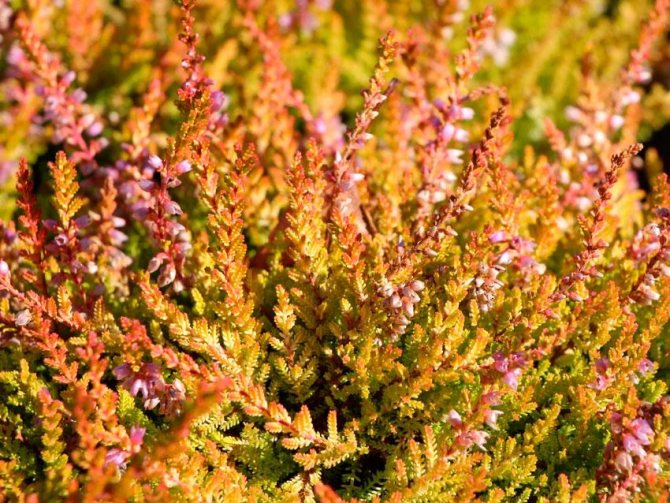

Unique honey plant
Supplementing the botanical name of the culture with the humble adjective common, people never stopped loving and respecting these hardy flowers. It was said about him that where the heather settled, a man could survive. It was especially appreciated by beekeepers as the latest honey plant, producing nectar at the end of summer and even in autumn. This late bribe was poetically compared by the people with a belated last love. No one is indifferent to this famous honey - either it is completely rejected for its tart and characteristically bitter taste, or they fall in love with it for life. Moreover, the bees themselves, giving 200 or more kg of honey from each hectare of heathers, are more likely to be the first and absorb it hard, therefore, usually in winter, honey is pumped out completely, replacing it with others for the winter bee feeding. It has a special yellowish-red color, strong aroma, gives a slow fine-crystalline setting and has unique medicinal properties.
Using heathers for grazing sheep, the inhabitants of the gray regions of Germany managed to breed their special breed, a distinctive feature of which is its extraordinary endurance and the ability to eat this unusual pasture almost all year round.
What is the use of heather
The plant contains special substances that give it anti-inflammatory, disinfectant, cleansing and other useful properties. Flowering shoots are considered medicinal raw materials; infusions, decoctions, teas, powders are prepared from them. Heather is used in both folk and traditional medicine to treat:
- renal pathologies;
- sore throat;
- bronchopulmonary diseases;
- rheumatism;
- radiculitis;
- diarrhea;
- dermatological diseases;
- nervous disorders;
- diseases of the digestive system;
- wounds, ulcers on the skin;
- burns.
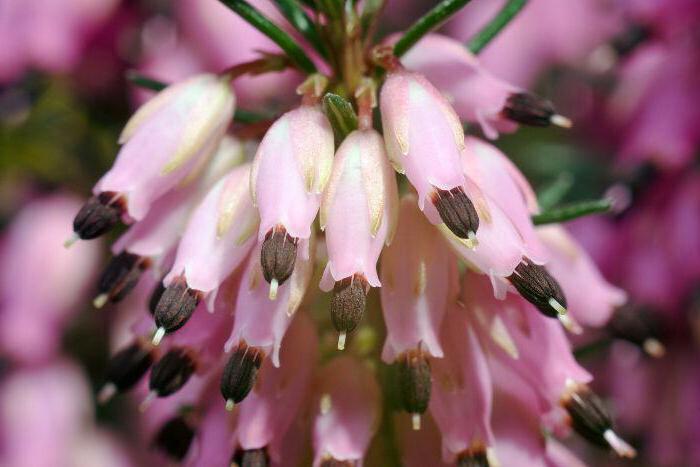

Rubbing in heather infusion slows down the hair loss process and improves its appearance. Before using the plant for medicinal purposes, it is advisable to consult with specialists. It is contraindicated when taken orally for people with low acidity of gastric juice.
Heather home: photo
Description and properties of heather
The culture is classified as an evergreen creeping plant of the Heather family. It grows on almost all continents, in our country it is distributed in European regions, in Siberian pine forests and peat bogs.
Here's a botanical description of heather:
- A perennial shrub that looks like a short coniferous tree or juniper.
- Stems are medium-sized, up to half a meter high, dense, lignified, resinous.
- The leaves are green, narrow, hard, wrapped in tubes, due to which they resemble needles. The foliage is plentiful, densely grouped, forming a dense green background. One bush has about 70-80 thousand leaves.
- The flowering season occurs at the end of summer and lasts until the first cold weather. Fragrant buds are grouped in lush, racemose inflorescences. The colors are discreet, of different shades for different varieties.
- Fruiting in seed pods, the seeds are very small, carried far away by the wind, allowing the crop to multiply quickly by self-sowing.
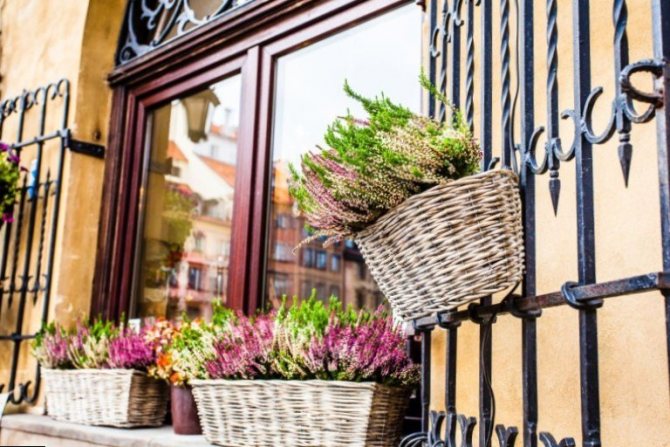

Heather is classified as an evergreen creeping plant of the Heather family.
In folk medicine, the plant is also in demand. Doctors prepare infusions and decoctions from it, which have antibacterial and anti-inflammatory effects. The broth helps dissolve kidney stones, improves well-being in diseases of the liver and gallbladder. Tinctures are used for colds, gout and cystitis.
For many centuries it was considered a good national omen to settle near heather thickets. It was said that where the heather lives, it will be comfortable for a person. Beekeepers appreciate the culture as the latest honey plant, allowing bees to collect nectar even in late autumn.
Suitable soil
The plant prefers to live on peaty, sour soil. It starts to hurt if planted in alkaline soil. He does not want to put up with an excess of organic matter. Watering the heather with water acidified with ordinary table vinegar will help in such cases. We'll have to urgently start preparing a suitable soil.
For the comfortable existence of this graceful shrub, a mixture of components is ideal:
- high-moor peat - 3 parts;
- river sand - 1 part;
- coniferous sawdust - 1 part;
- soil from under growing conifers - 1 part.
Conditions for growing crops in an open area
To grow heather, you need to familiarize yourself with the optimal conditions for its cultivation.
Lighting and location selection
Before planting heather in your garden, you will have to find a suitable place to grow it. Many people believe that this plant is unpretentious to care for and therefore grows anywhere, but this is not the case. The flower is undemanding to lighting, and therefore it can be planted in a shaded area, which is not always illuminated by the sun.When choosing a suitable place in the garden, pay attention to how it is blown by the wind.
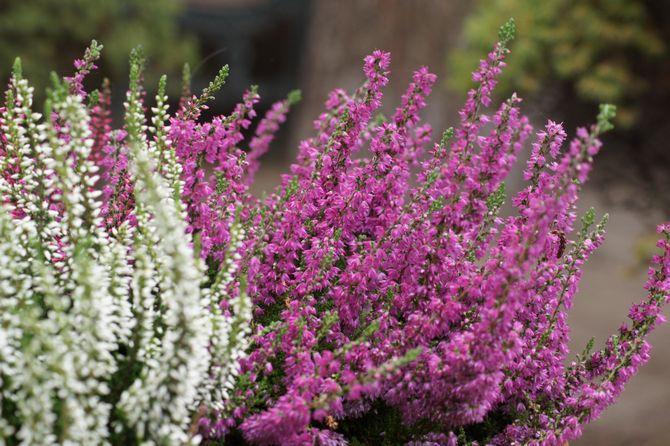

The site must be reliably protected from wind gusts so that the seedlings do not break from strong winds.
Optimum temperature
The plant has poor frost resistance and therefore it is better to figure out in advance the optimal temperatures for growing it. People who have been breeding heather for many years recommend growing it in winter at temperatures around 5-10 degrees Celsius.
To protect the bushes from hypothermia, soil mulching is carried out at the end of autumn.
The optimal temperature in the summer is considered to be indicators that do not exceed twenty degrees above zero. It is contraindicated to grow flowers near heat sources, since hot and dry air negatively affects growth and flowering.
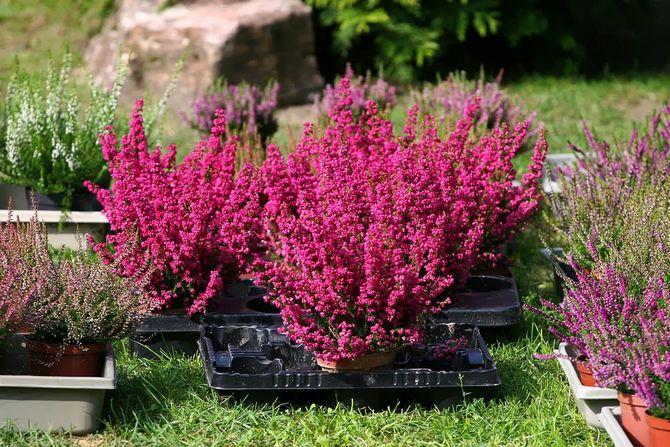

Humidity
In order for the planted heather to grow and develop well, you need to monitor the moisture level. In this case, special attention is paid to soil moisture. It is a moisture-loving plant that needs to be watered frequently. If the soil is too dry, the bush will begin to dry out. You also need to monitor the humidity of the air. It is known that dry air negatively affects the growth of the flower. Therefore, care must be taken to ensure that the degree of humidity is 80-90%.
Suitable soil
Experts advise planting heather in soils with a high acidity level. If the acidity is too high, it is reduced with citric acid, peat or sulfur. You can not grow bushes on alkaline soil, as they will quickly die.
See also
Description of the species and varieties of garden poppy, planting and care in the open fieldRead
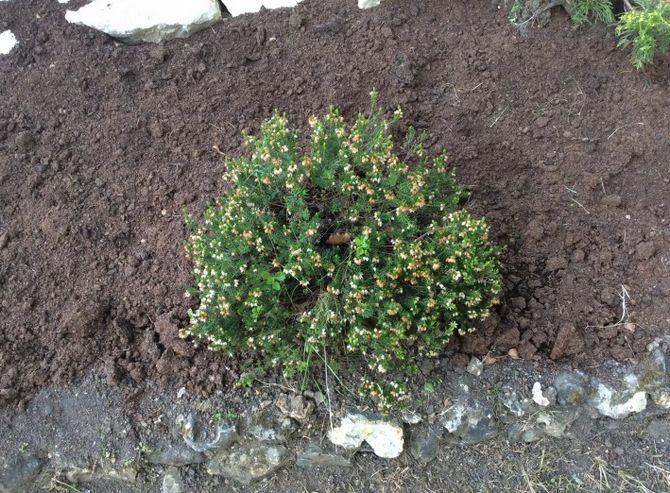

The growth and development of heather is facilitated by micronutrients that must be contained in the soil. To make the planted bushes grow better, sand with peat and sawdust is added to the ground. Also, under each plant, you can add 60-70 grams of sulfur, which accelerates the growth of heather.
Best and worst neighbors
People who have never cultivated heather are interested in what plants it is best to plant with. All varieties of northern orchids are considered good neighbors. If planted with heather bushes, they will bloom several weeks earlier than usual. Moreover, they will bloom 5-8 days longer. They can also be planted near the pulmonary gentian that blooms in early summer. These flowers are considered tall, and therefore they should grow behind the heather.
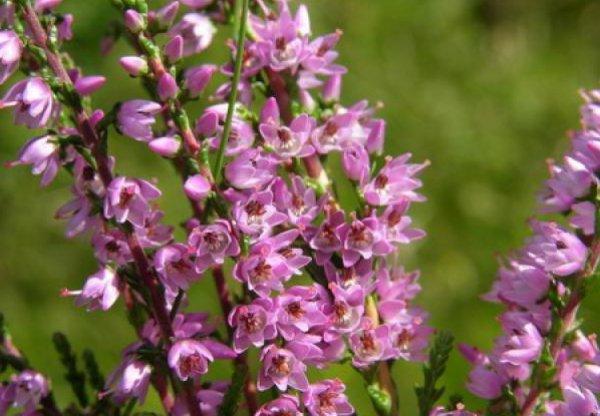

Vegetables are considered bad neighbors because they consume a lot of nutrients and slow down the growth of flowers.
How is heather propagated?
There are three methods:
- Division of the bush.
- Seed reproduction.
- Cuttings.
Most often, the separation of the new bush from the main one is used. For this purpose, the bush must be dug out, the roots must be shaken off a little, divided and planted.
The grafting method is used. The apical branches are cut and rooted. The length of the handle is 4 centimeters. The twigs are planted in a greenhouse for rooting, and planted in the ground in the spring.
Seed propagation is used mainly by breeders to create new varieties and hybrids. Species specimens have very small seeds; they should not be covered with earth. They are evenly distributed over the moist soil surface. Crops are protected from the effects of cold and sun.
Indoor heather: description of the plant
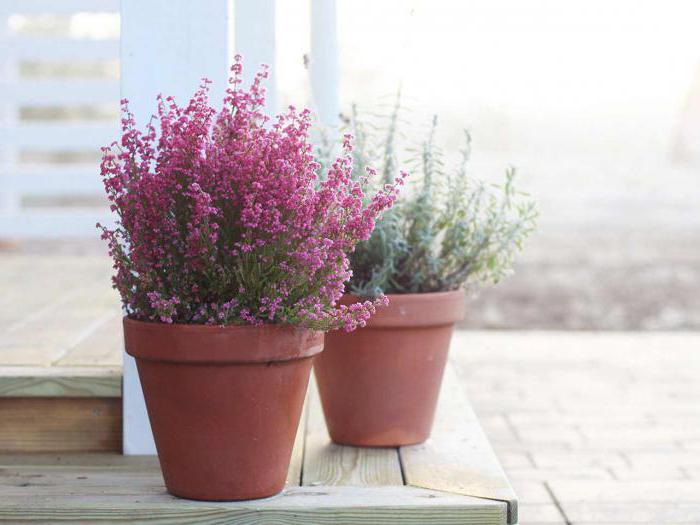

The plant belongs to the genus Heather of the Heather family. The main characteristics of heather are as follows:
- The culture grows in the form of a low or medium-sized shrub. The height ranges from 25 to 75 cm. This shrub has a lot of leafy shoots that create a dense and beautiful crown.
- The plant belongs to evergreen crops, for which many flower growers and gardeners like it.
- The leaf of culture has three facets. They curl slightly at the edges, forming a neat tube.
- The plant blooms with small flowers that have a pink or lilac color. The flowers are oblong, reminiscent of a bell. The bells are grouped into neat bunches.
- A distinctive feature of the plant is the pleasant aroma of its flowers.
- Flowering lasts from June to October. During the autumn period, the foliage of the plant changes from green to bright burgundy and pale yellow.
- The plant is an excellent honey plant. Heather honey has excellent taste.
- The plant is also used for decorative purposes. It is usually planted along paths or used to form a landscape of alpine slides.
- Heather is often grown at home, as the plant is unpretentious and undemanding to the type of soil. Caring for indoor heather is an easy task, you just need to water the plant in a timely manner.
Appreciated by man
Unpretentious and unusually attractive for its originality, the heather plant has found wide application among urban landscape designers. With pleasure, it is grown both in small gardens and in spacious summer cottages. This shrub looks harmoniously with tall or dwarf conifers. It goes well with ferns, alpine plants, berry crops. Forms cozy meadows under medium-sized deciduous trees. The photo below shows heather in harmony with fir trees.
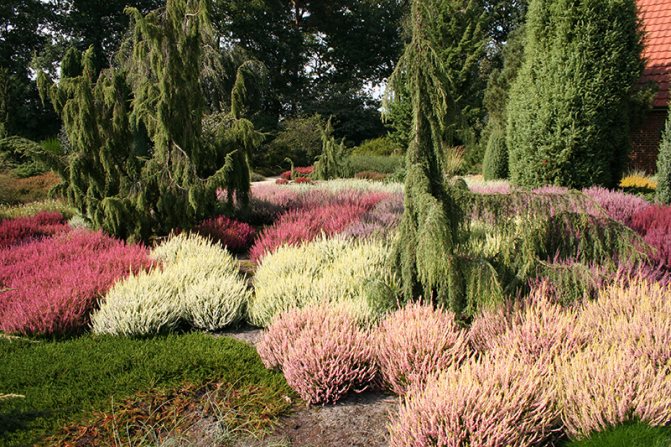

A shrub growing in natural conditions does not take more moisture from the surrounding soil than it needs to maintain its normal life. This unusual property of plants is called "physiological dryness".
On small backyards or garden plots, heather looks great, located in decorative containers, boxes and pots. This gives style to the decoration of the garden area.
It will get along well in the home interior as an unpretentious but wonderful indoor plant.
Using heather
Economic use in the old days
- The botanical name for heather - Calluna - comes from the ancient Greek word for sweeping. From antiquity to the Middle Ages, in most European countries, dwarf shrubs were used as brooms.
- The plant was used as a building material. In Scotland, Ireland, you can still see huts covered with thick heather branches. The ancient Scots combined dry stems with clay and straw, and built entire houses from this material.
- Baskets were woven from heather shoots, the roots were used as fuel, which was of particular importance in the mountainous, treeless terrain.
- Heather foliage was a popular stuffing on mattresses.
Like medicine
The health benefits of heather have been known to mankind since the dawn of our era.
- The decoction of flowers was recommended for urinary tract infections, snake bites, fever as a diaphoretic.
- The flowers contain bioflavonoids - especially a lot of quercitin and mitricin, and other important compounds for the body - tannins, saponins, arbutins.
- Thanks to scientifically proven antibacterial, disinfectant and diuretic effects, heather really deserves attention as a remedy for cystitis, urethritis, kidney stones, enlarged prostate.
- Heather flower tea can effectively relieve diarrhea, abdominal pain, colic.
- Many homeopaths recommend the plant as a detoxifying agent.
- Recent studies show that heather extract is useful in the treatment of rheumatic diseases (arthritis, gout).
Honey plant
Heather is a melliferous plant whose nectar is used by bees to produce honey that is unique in terms of taste, texture, and beneficial properties. Heather honey is a niche in the market and therefore has a higher price tag. Extremely dark, thick, with a beautiful ruby hue, it has a sharper, slightly bitter, sweet taste, which is especially loved by connoisseurs.
Heather honey is extremely rich in easily digestible iron, valuable amino acids, and enzymes. In apitotherapy it is recommended for colds, sore throats, rheumatic, digestive diseases, general weakness of the body.
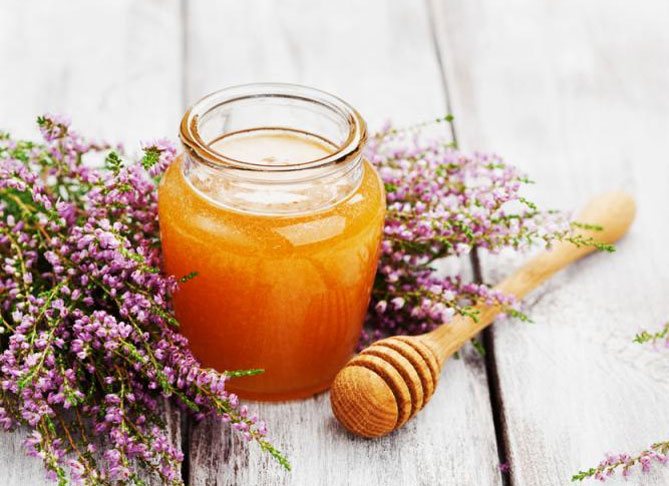

Use in landscape design
Heather will fill the garden with beautiful flowers. Even after flowering, the leaves of the plant change color depending on the variety, being an interesting element of the landscape.
Landscape designers recommend planting heather alone or in large groups, paying particular attention to rocks, slopes, and the edge of perennial beds. A pot of heather in the garden or on the balcony will become an important element of the decorative autumn composition, it should be combined with apples, pumpkins and colorful asters.
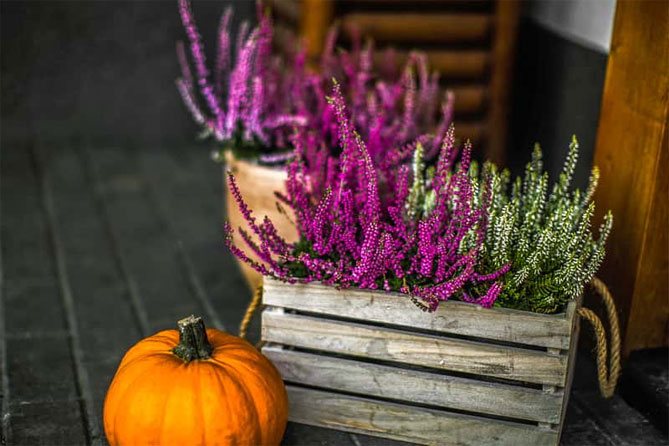

It is better to carry out planting work in early September, when the shrub is in full bloom. Seeing what color the bushes are, it is easier to compose them into an interesting multi-colored whole, so as not to create a one-color spot.
Garden heather can be a great replacement for a piece of lawn, fill in an uncomfortable slope, or simply liven up a landscape like a shrub in a flower garden.
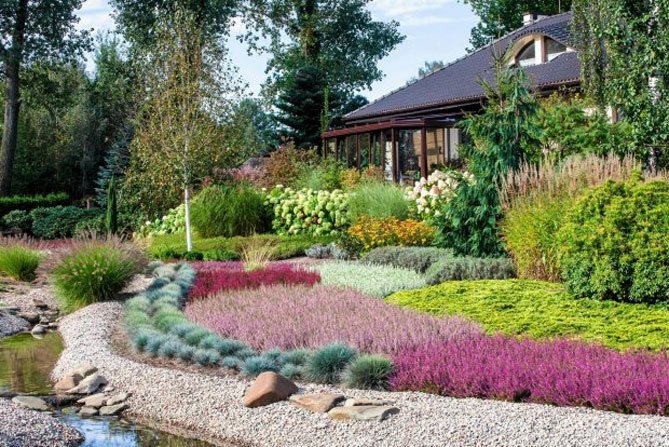

The modern choice of colors and shades leaves gardeners a huge field for imagination; plants with shoots of two different colors are extremely interesting. These two-colored heathers are a real decoration in the autumn garden, when most of the flowers have already faded.


Heathers look good in the company of rhododendrons, azaleas, junipers. They look great in rock gardens and as ground cover plants. Whole areas of the garden can be planted with shrubs, imitating forest glades.
Do not be afraid of the practical use of heather - you still need to cut off the stems, and from cut flowers you can make a healthy and tasty tea that heals and fills the day with a pleasant aroma and floral taste.
Blooming heathers are a sign of approaching autumn. Their colors adorn flower gardens that lose their charm at this time of year. The bright colors of heather in the garden make us feel positive on cold days.
Top dressing
Heathers have low soil requirements, so they do not need intensive fertilization. There are many heather-friendly preparations on the market that can be used to nourish the bushes a little.
A convenient solution is to use slow-acting formulations in granules. You should also pay attention to preparations for acidifying the soil, that is, urea or magnesium sulfate. Heathers can also be supplied with nutrients that are high in potassium, which will help plants flower well.
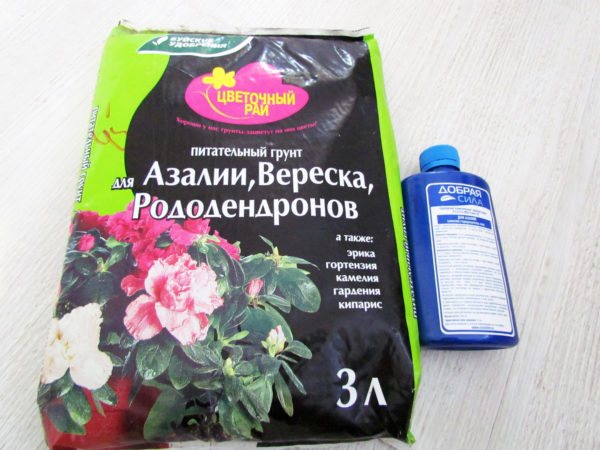

A very important element of feeding heather is the introduction of the so-called mycorrhiza. It is a natural process involving the symbiosis of plant roots and seeds with fungi. As a result of “working together” with these beneficial organisms, heathers will receive a better water supply and thus become more drought tolerant.
Nutrients, including those that are difficult to digest such as iron or phosphorus, will become more readily available to them. Their resistance to root pathogens responsible for late blight and fusarium disease will increase, as will unfavorable environmental factors such as toxic compounds from the soil or unfavorable pH. Live mycorrhizal mycelium can be used for heather. It is available at garden supply stores.
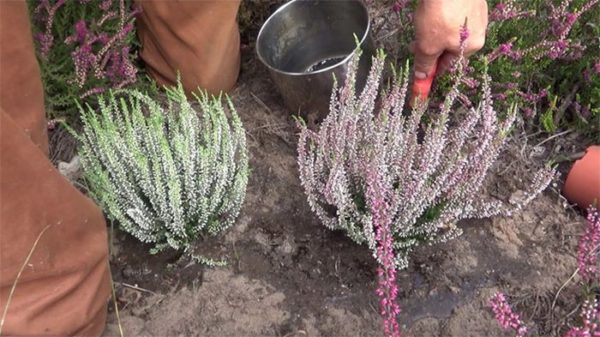

Immediately after spring pruning, it is worth feeding the plants, preferably with a slow-acting fertilizer. Fast-acting fertilizers must be used skillfully because, if applied too intensively, they can cause excessive soil salinity. Heather is very sensitive to this.
Slowly distribute nutrients around the bushes. Do this only once a season, applying 4-5 g per plant. Use fast-acting nutrients only 2 or 3 times.They should be introduced no later than by the end of June (the dose is similar).
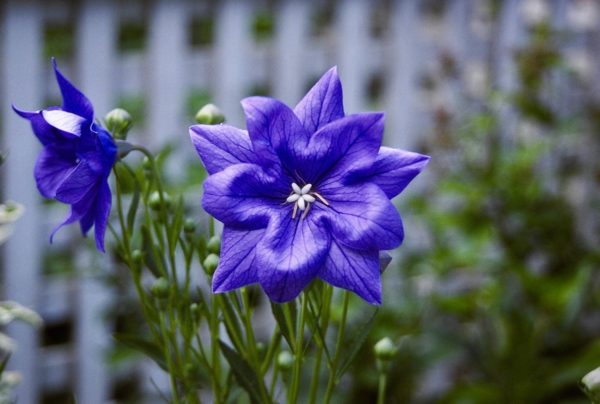

You may be interested in:
Platycodon planting and outdoor care Platycodon belongs to the bellflower family. It includes only one species that is in the wild ... Read more ...
Heather: planting and care in the open field
First of all, you need to keep the site tidy. Regular weeding will keep the soil from depleting. Good growth and the ability to resist heather diseases will provide a complex liquid feed for conifers. Only they take into account his need for acidic soil.
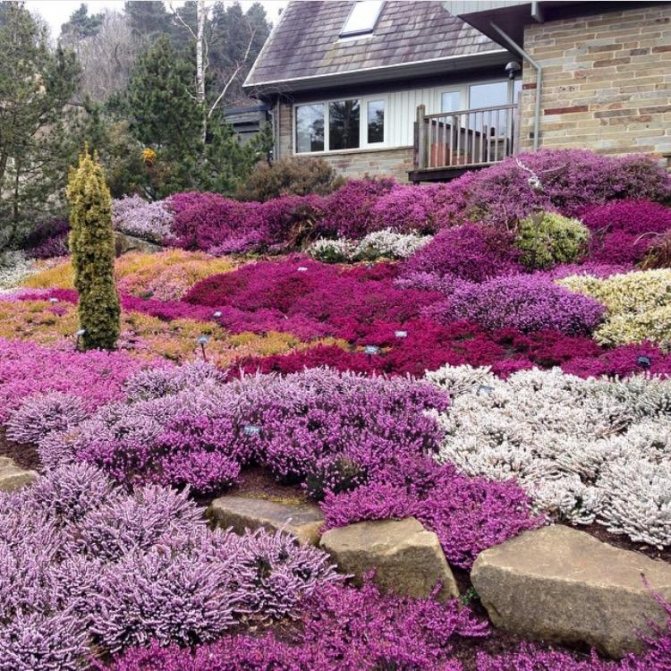

In order for the shrub to grow thick and delight the eye with its beauty, you need to carry out a small pruning. The upper branches are trimmed in late autumn by about five centimeters. Pruning can be done in the spring, before bud break.
Heather hardly tolerates severe frosts. Therefore, it is grown in well-drained soils. This will help to avoid freezing of stagnant water and freezing of the heather garden.
Heather propagation
When propagating heather in nurseries, the most common method is cuttings. Thus, a large amount of planting material can be obtained, which will retain the properties of the mother bushes. In the case of plant propagation by seeds, a rather difficult job is ahead. In addition, there is no guarantee that you will get plants with the same decorative properties as the mother bush. Gardeners also often use layering to propagate heather. Let's consider these and other methods in detail.
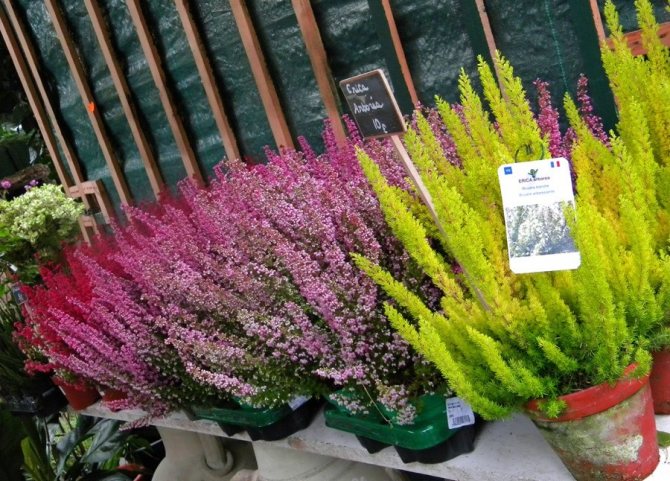

Horizontal layering
With a significant growth of heather bushes, they can be partially moved to another place using extra shoots. When the branches touch the ground, they are able to root without assistance. Therefore, the easiest way to grow a young plant is to dig in a twig. To do this, with the onset of summer, the shoot is bent to the ground, fixed with a wire brace or in another way, sprinkled with a layer of peat 5-7 cm and watered. During the summer, the dug-in twig is periodically moistened so that the soil is evenly moist.
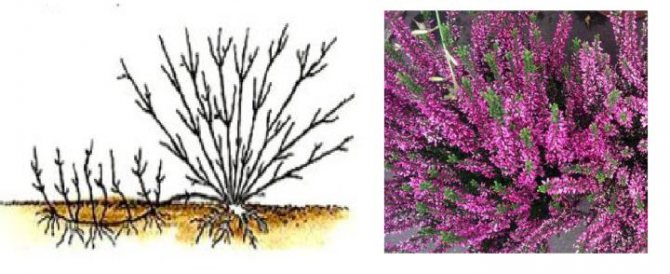

It is not recommended that the plant experience swings of drought and strong moisture.
A year later, at the end of spring, the rooted cuttings are separated from the bush and dug out together with an earthen lump. You need to try to dig so that the soil does not crumble. A young plant is planted in a selected place. If you have not yet decided on the landing site, you can plant the heather in a container.
Varieties and varieties
Heather is a low shrub (35-75 cm in height), which is familiar to everyone for its fragrant flowers that adorn the elongated inflorescences-brushes of the plant. Outwardly, the flowers resemble bells, they have different colors, just like the leaf plates of the bush.
Quite often, heather is confused with a plant like Erica. Some people think that Erica is just a type of heather. But these are two completely different shrubs. Heather has more than 500 varieties, which can be formally divided into several categories based on the external characteristics of the plant.
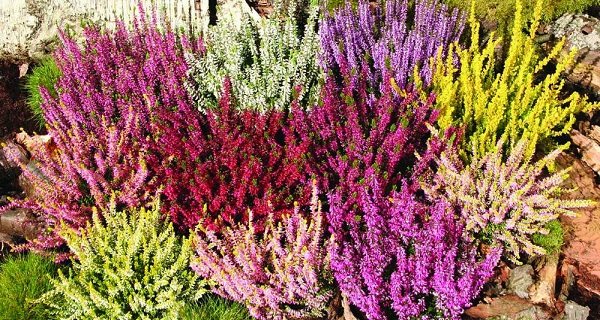

Varieties with green leaves
Views:
- Allegro... The bushes of this variety reach a height of about 55-65 cm. The diameter of the flowering "cap" is 50 cm. It belongs to the category of evergreens. It has a rather dense crown, strewn with dark green leaves in the form of scales and glossy red flowers. The flowering period is in late July - late October. It is resistant to frost, however, it is better to cover very young seedlings (first years) before the start of frost;
- Carmen... This hybrid variety was developed by Dutch breeders. It is quite popular in Europe. The shrub is small (only 35-45 cm in height), all covered with small dark green leaves. The stems are covered with brown bark, at the top of them are crowned with inflorescences, consisting of many pink-purple flowers.Less frost-resistant than the previous variety, so cover should be provided for the winter.
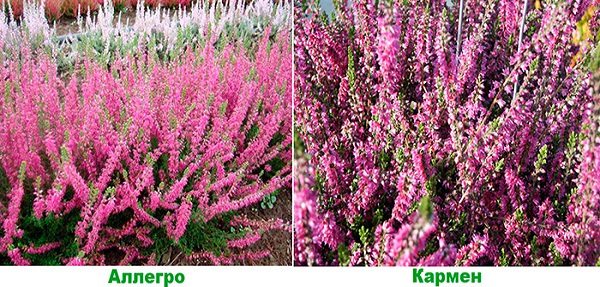

Species with white flowers
Varieties:
- Alba. A low shrub (40 cm high) with an extensive crown (60 cm in diameter). Stems are straight, decorated with dense inflorescences in the form of brushes. The flowers are white, the leaf plates are saturated green;
- Alexandra. A compact shrub (30 cm high and 35 cm in diameter) with dark green foliage and creamy flowers. By the end of the flowering period, the color of the flowers changes to dark red.
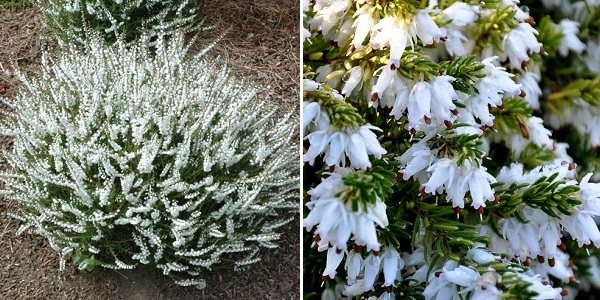

Plants with silvery leaves
Popular varieties:
- Silver Knight. This shrub grows to a height of 30-35 cm. The crown has the shape of a pillow (40-45 cm in diameter), covered with dark brown bark and dotted with light purple flowers. The leaves have a silvery tint with a characteristic edge. Closer to winter, the shade of the leaves will change to burgundy. Quite resistant to frost, but it is better to play it safe and cover the shrubbery during the winter;
- Peter Sparks. An extensive bush 55 cm high and a crown diameter of 65 cm. The stems are covered with brown bark, the tops are crowned with double flowers of a dark pink color. Leaf plates in summer and autumn have a dark green color, and gray-green in winter and spring.
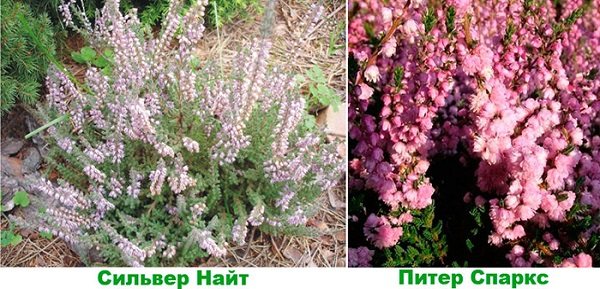

Golden shrubs
Common types:
- Gold Hayes. The bush reaches a height of 45 cm. The crown has the shape of a ball, covered with small leaves of lemon-yellow color. The flowers are white. Flowering peaks in August and lasts until the end of October. Frost-resistant;
- Boskup. The bush reaches a height of 35 cm. The crown is small, compact, covered with lilac-pink flowers. The foliage has a golden tint, which is replaced by a reddish-copper one closer to autumn.
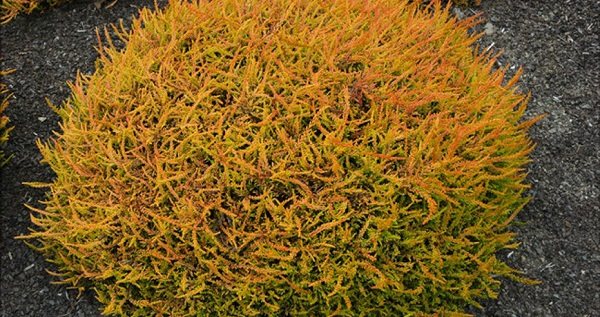

Plants with double flowers
Shrub varieties:
- Alba Plena. The bush grows to a height of 55 cm (the same amount reaches the crown in diameter). The bush is dotted with light green leaves and white double inflorescences. The flowering period is late July - early September. On especially hot and dry days, additional watering is required;
- Monica. A wide, spreading shrub, reaching a height of 45 cm. The diameter of the crown is much larger than the others (about a meter). The branches of the bush are strong, dense. The stems are crowned with reddish-pink inflorescences and dark green leaves, which are covered with a characteristic gray bloom by winter.
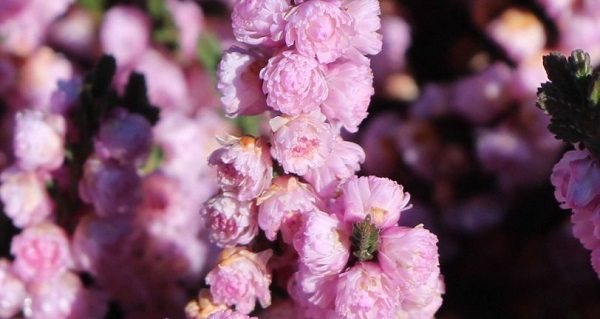

Bushes with closed buds
Varieties:
- David Eason... The shrub is shaped like a ball. The bush reaches a height of only 20 cm, the crown is also small - 25 cm. The "cap" of the plant consists of lilac-pink flowers and dark green leaves;
- Marlin... A low (25 cm) spreading (55 cm) shrub with mauve buds instead of open flowers.
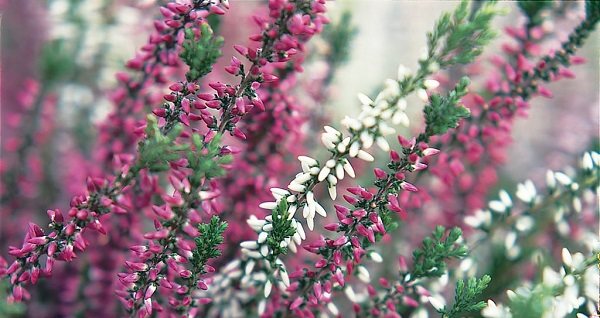

Necessary activities
As soon as the bush was brought home, perform the following manipulations:
- Using a shower head, rinse the plant with cool water. This will have a positive effect on the condition of the plant.
- Transplant the heather into a larger container. This culture has a poorly developed root system, so the plant is planted to a depth of fifteen centimeters to prevent decay. The roots are carefully straightened, they should look outward, and if this is not done, then the heather may not take root.
- The pot with the plant is placed in a tray with pebbles or wet peat. The ideal planting time is from April to early June.
Purchase of seedlings
The plant is painful to transplant, because it enters into symbiosis with the myceliums in the soil. Buy seedlings only with a closed root system (in containers) - this way mycorrhiza and roots will be completely preserved. The fact is that even after death, the plant has a viable appearance for a long time (leaves and flowers do not wither, the stems do not droop).
When buying, pay attention to the following points:
- The earthen lump should fit snugly against the walls of the container, there should be no delamination to restrict the intensive access of air that dries out the roots.
- The soil should be slightly moist, waterlogging leads to the death of the roots (the decay process may have begun).
- The seedling should have both old and young shoots in an elastic state and growth buds.
Transplant and reproduction
Don't worry about how to transplant heather. No tricks will help: an adult plant is hard to take root in another place. You need to acquire it growing in a pot. The roots should keep a clod of earth while planting the bush in the ground.
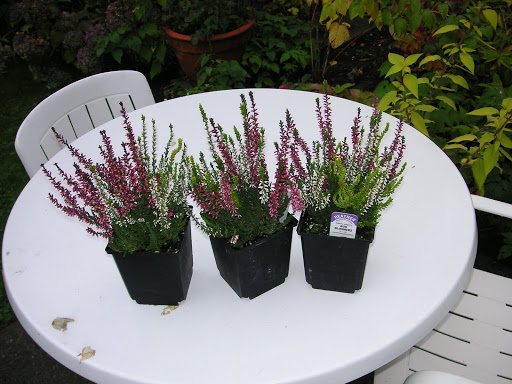

But a bush already growing in the garden is easy to propagate. You can use heather for reproduction in any way:
- rooting of cuttings;
- planting of apical cuttings;
- dividing the bush.
Propagation by apical cuttings
Lignified shoots will be needed. But only those that have no flowers are suitable. This method of reproduction is used when the shoots are ripe, at the end of the season.
You need to prepare a substrate for planting in advance. Take three parts of loose peat and one part of sand. Placing the cuttings in the prepared soil, they need to be watered a little. Once every ten days, when watering, fertilizing with microelements is carried out. Cuttings grow best at around eighteen degrees. In the spring, small heather bushes are ready to be planted in their designated place.
Choosing a place for heather
In order for the plant to feel its best, it needs to create conditions that will be as close to natural as possible. It is advisable to choose a place for planting such that in the daytime the plant is in the shade of trees, and in the morning and evening it basks in the cool sun. In an open area, the heather will not disappear, but the flowers will be small, and the flowering will be short.
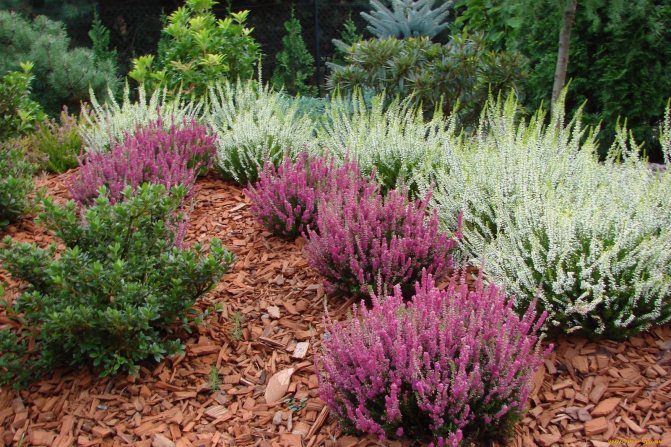

It is not worth planting heather in absolute shade, since you may not wait at all for flowering.
If your site has a swampy lowland, then when arranging a decorative corner, do not forget about drainage. The plant prefers moist but not wet soil. With excessive moisture, it will simply disappear. In arid areas, heather, on the contrary, will feel good, but it will not be possible to get a lush crown, and after a few years the buds will stop forming altogether.
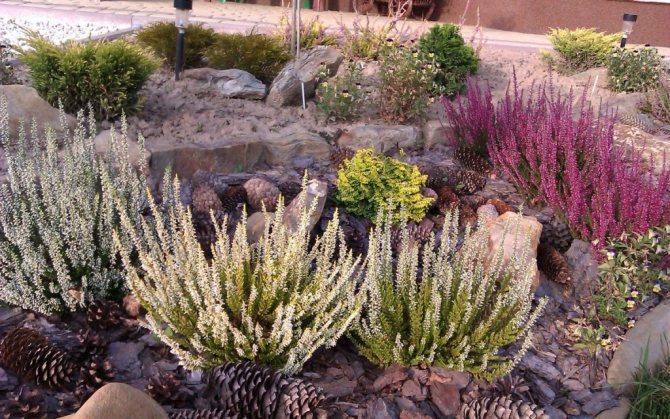

Features of heather
The heather plant branches strongly and spreads with small shrubs. Height is approximately 0.3-0.7 meters. It is an evergreen plant. The leaf plates have three edges and seem to roll up into a tube. The flowers give off a strong aroma, although they are small in size. They resemble lilac-pink bells in shape. Heather blooms in the second half of summer. But the plant becomes more beautiful as soon as the first frosts hit. Indeed, because of them, the color of the leaves changes to burgundy or yellow. Such a plant also serves for food purposes. It produces excellent heather honey, which is considered to be the most useful among others.
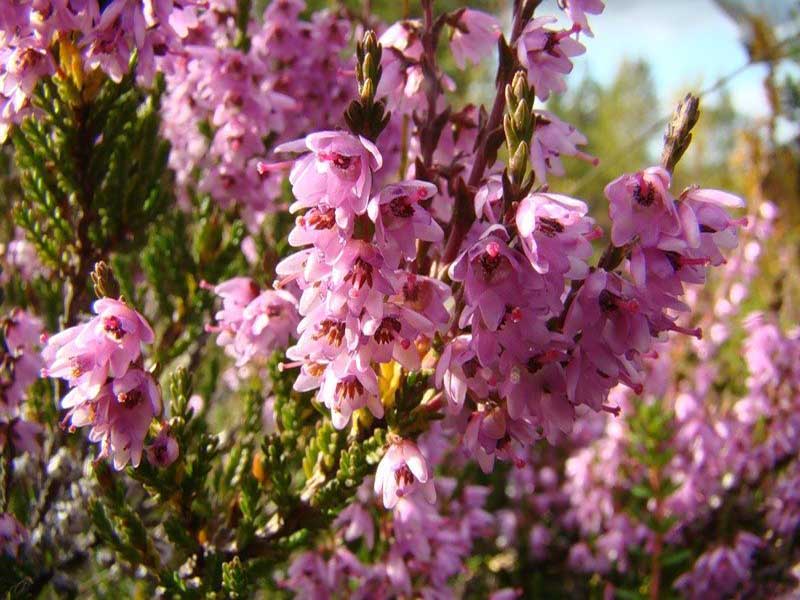

Common heather
Growing and care
Heather is not picky about care, but with a little attention, you will get a wonderful decoration for the garden, which will delight with its bright colors.
Watering and feeding
The plant does not need a lot of water. The exception is days when the weather is hot. The land can be thoroughly watered around the bushes once a week. Rainwater is ideal for irrigation. Do not flood the plants, as moisture stagnation leads to the formation of mold and fungi, as a result of which the plants will simply die.
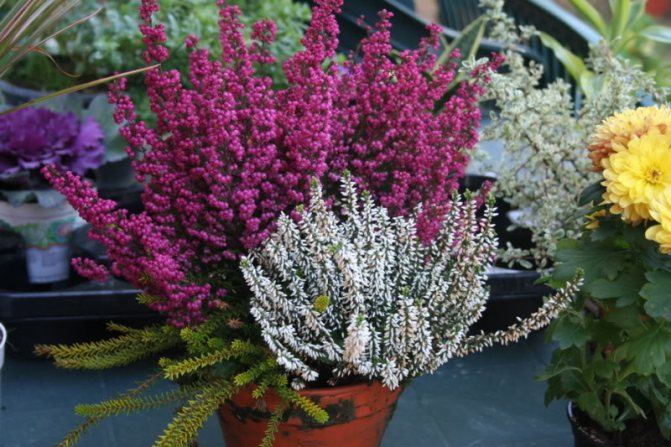

As for feeding, fertilizing heather is not a must. However, if the leaves have lost their natural color and become faded, it is advisable to use fertilizer for rhododendrons. In this case, feeding is done, as a rule, at the end of winter or in spring.
It is not worth using universal fertilizers for heather, especially if they contain calcium.
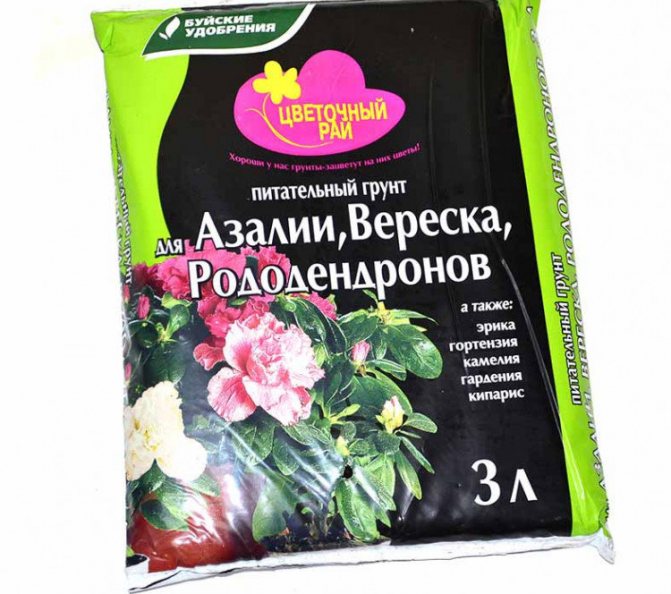

After feeding, the plantings are well watered with water, while avoiding the use of hard tap water.
Heather after flowering
In warm areas, heather hibernates without shelter, but if you have frosty winters, and even without snow, then it is better to play it safe and prepare the heather for wintering. To do this, after the onset of cold weather, spread peat around the heather bushes, and cover the bushes themselves with spruce branches, which will prevent them from freezing in winter, and in early spring will protect them from sunburn. They remove the shelter from the heather in April.
